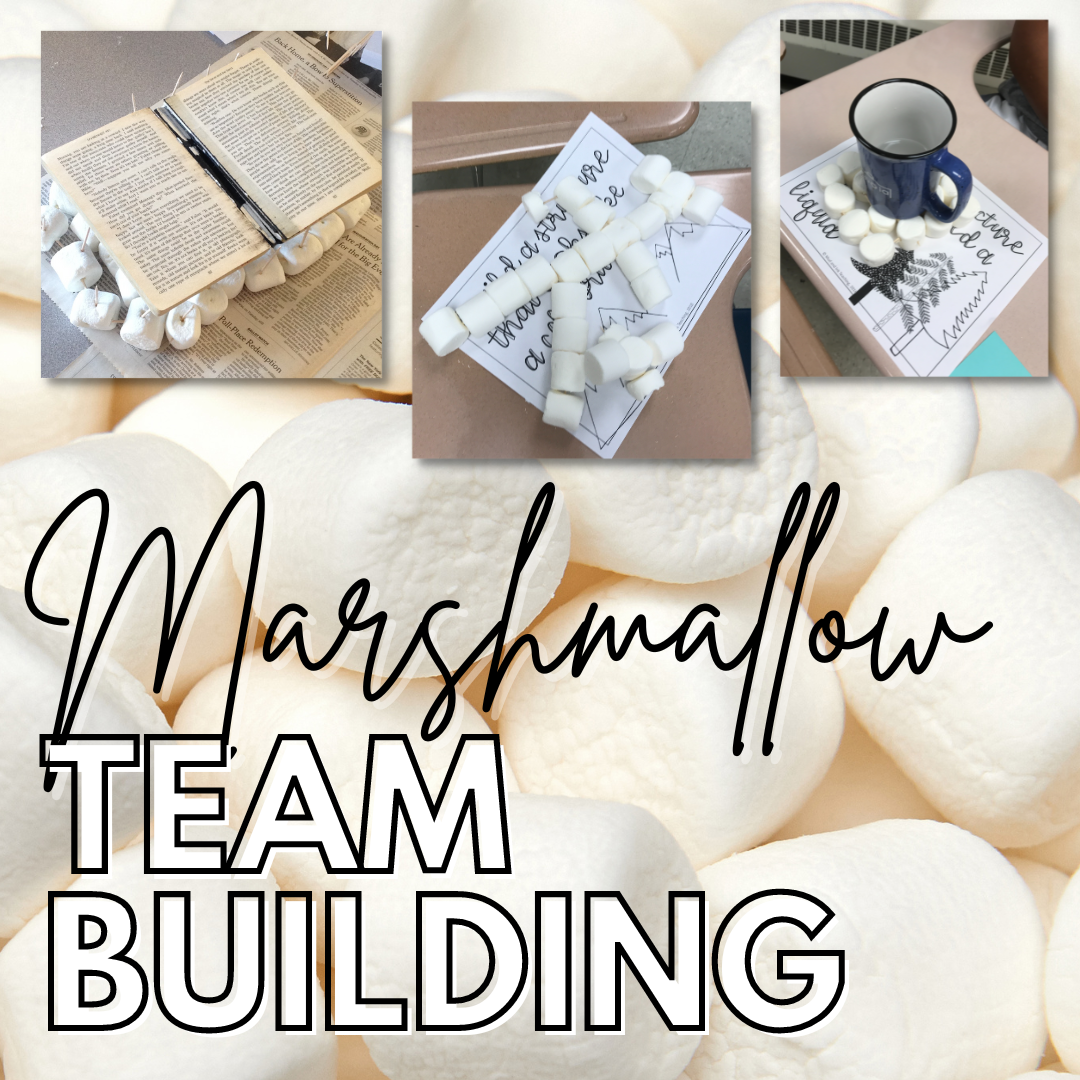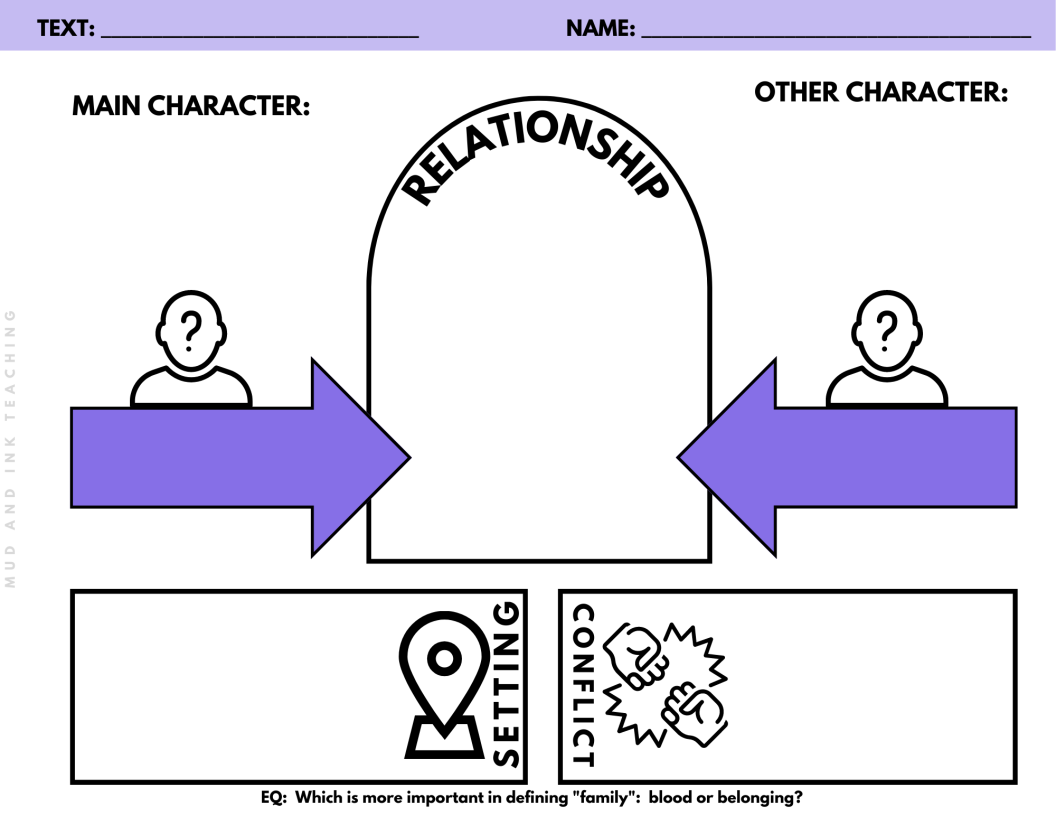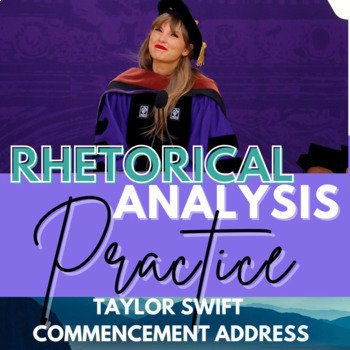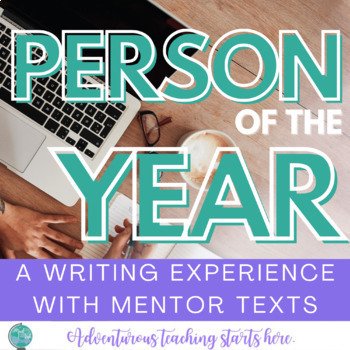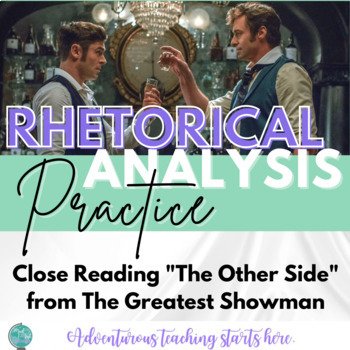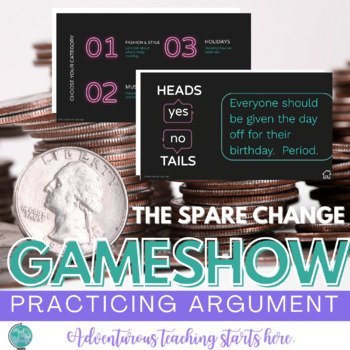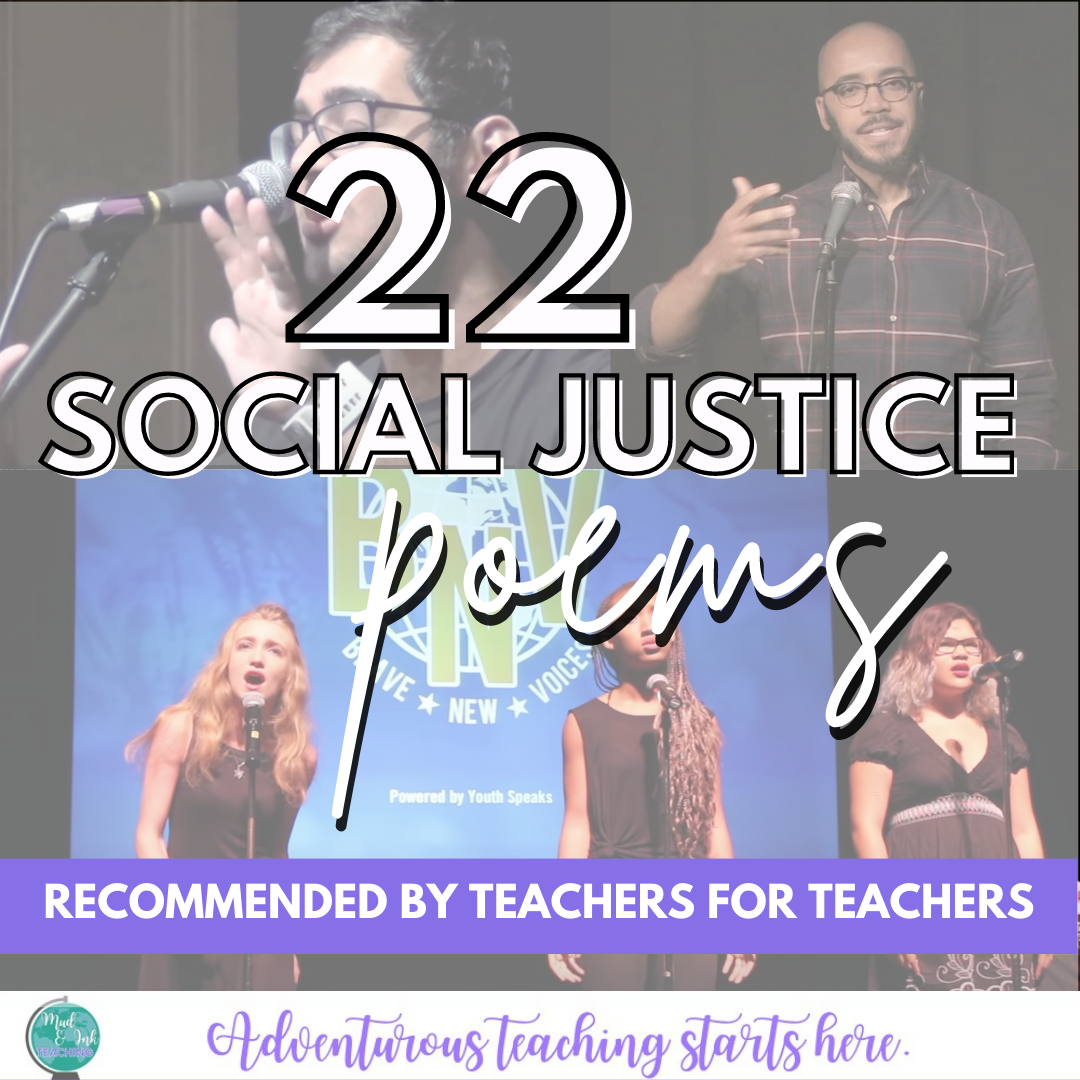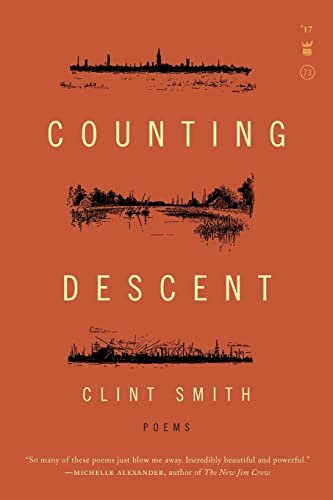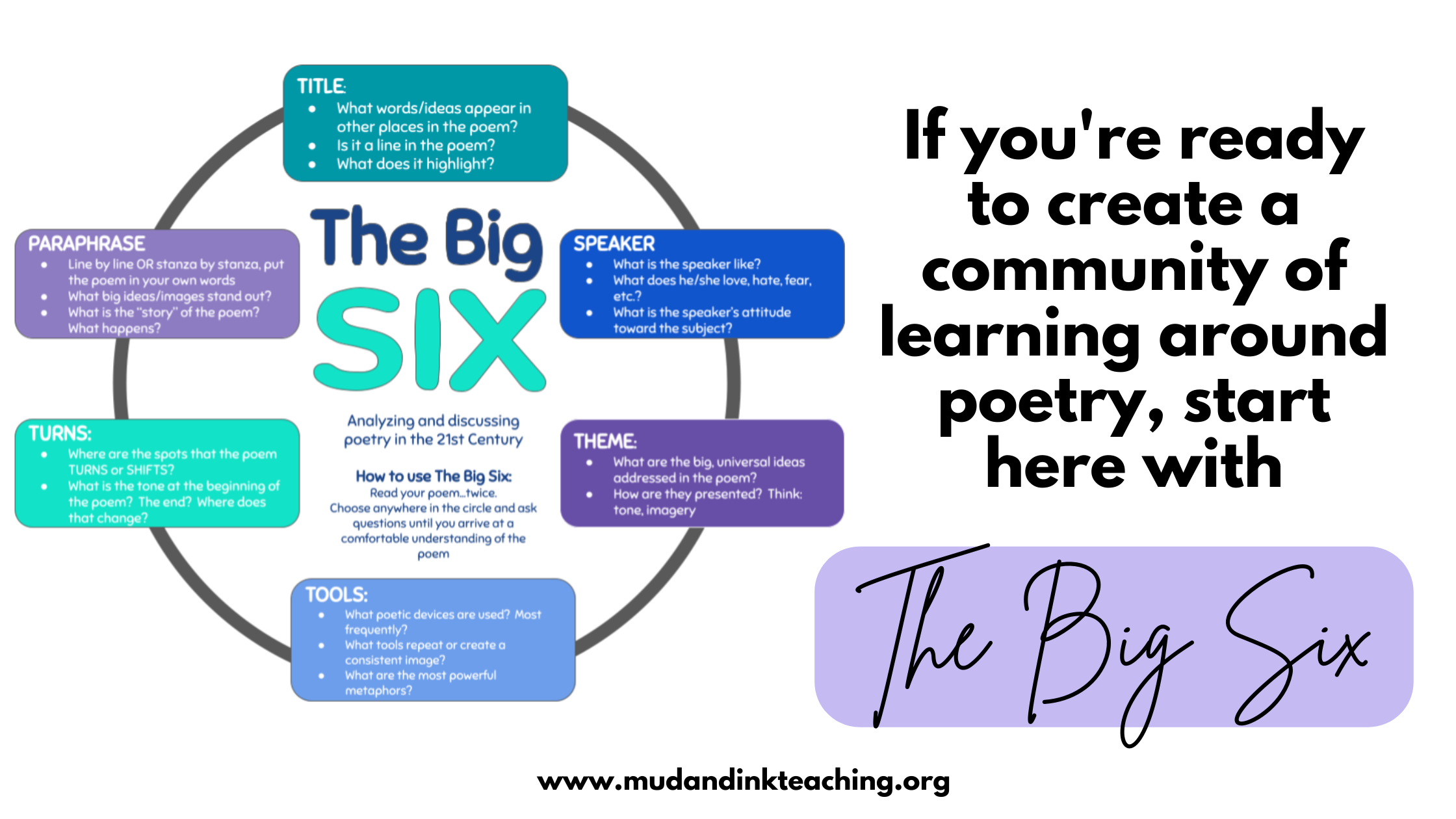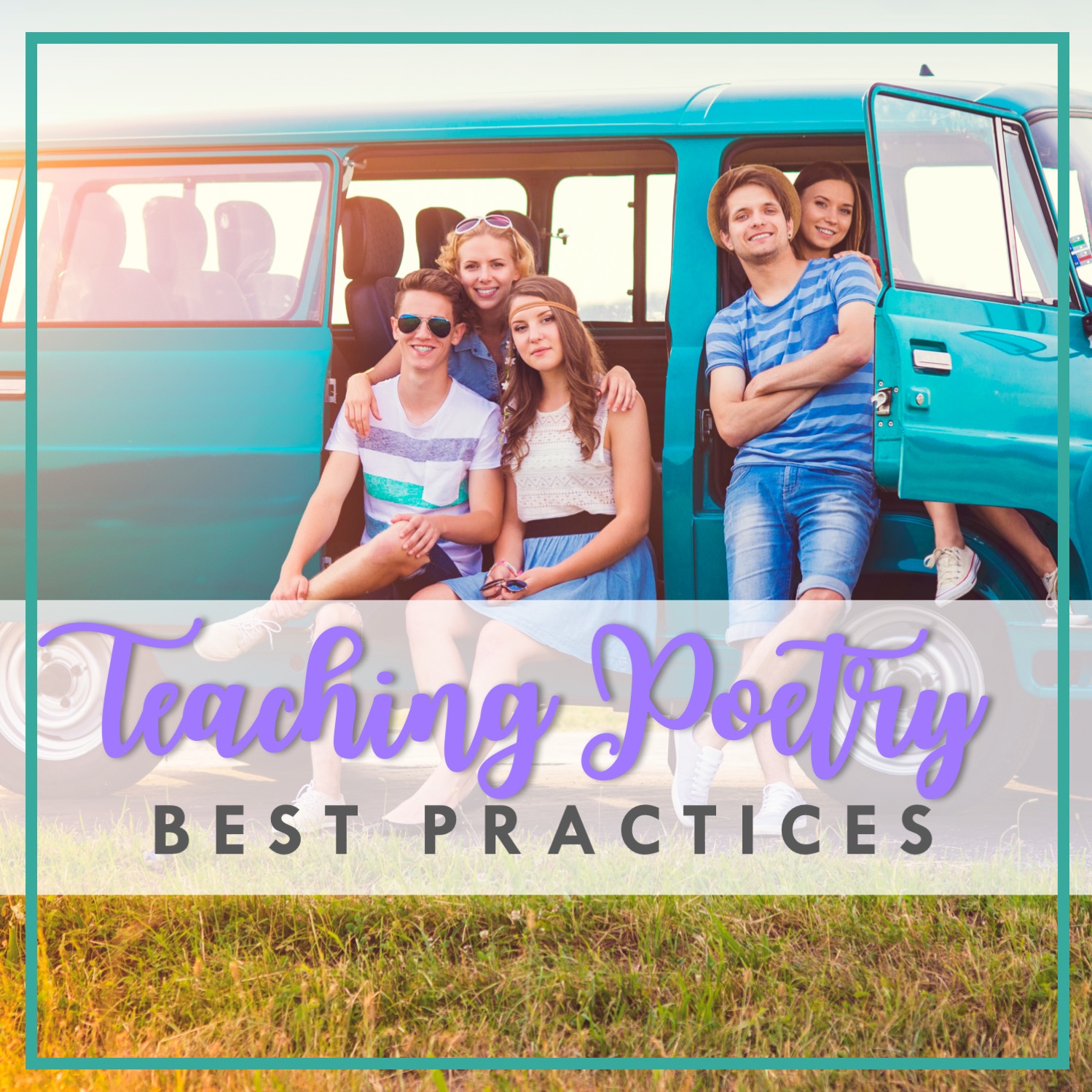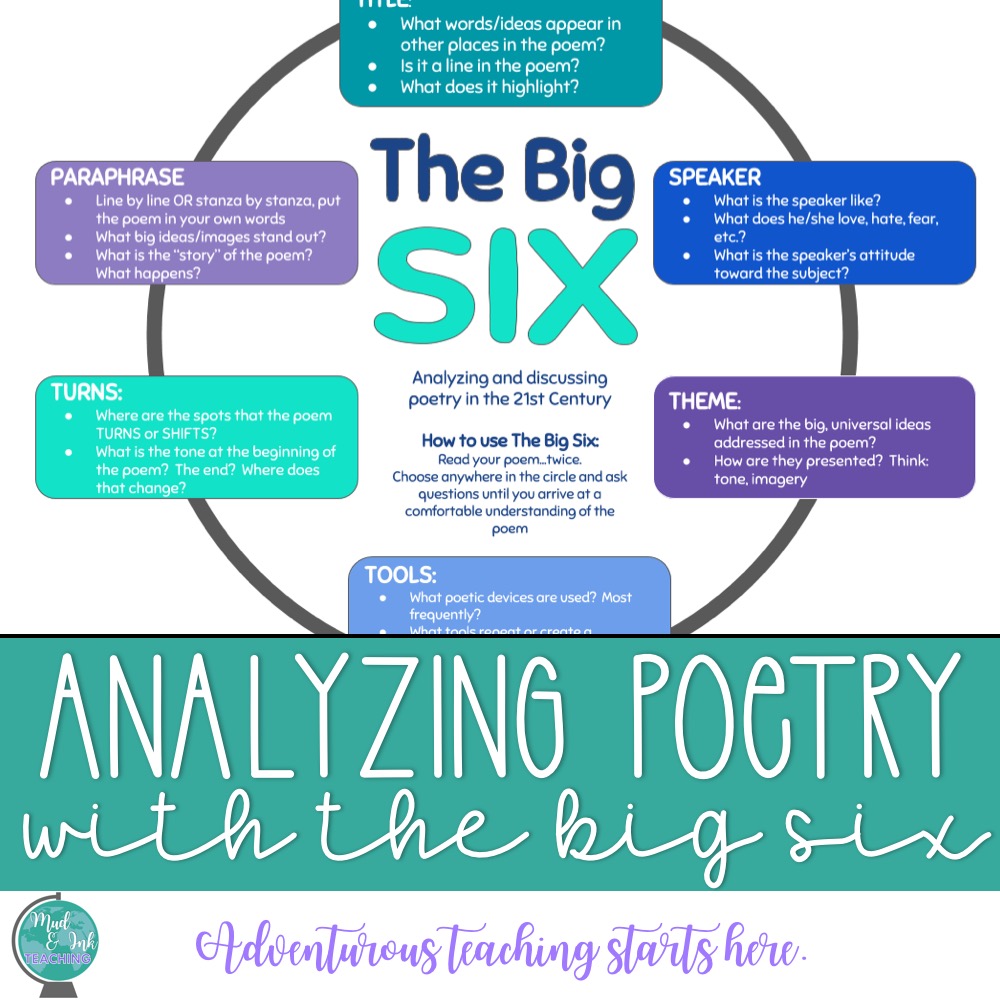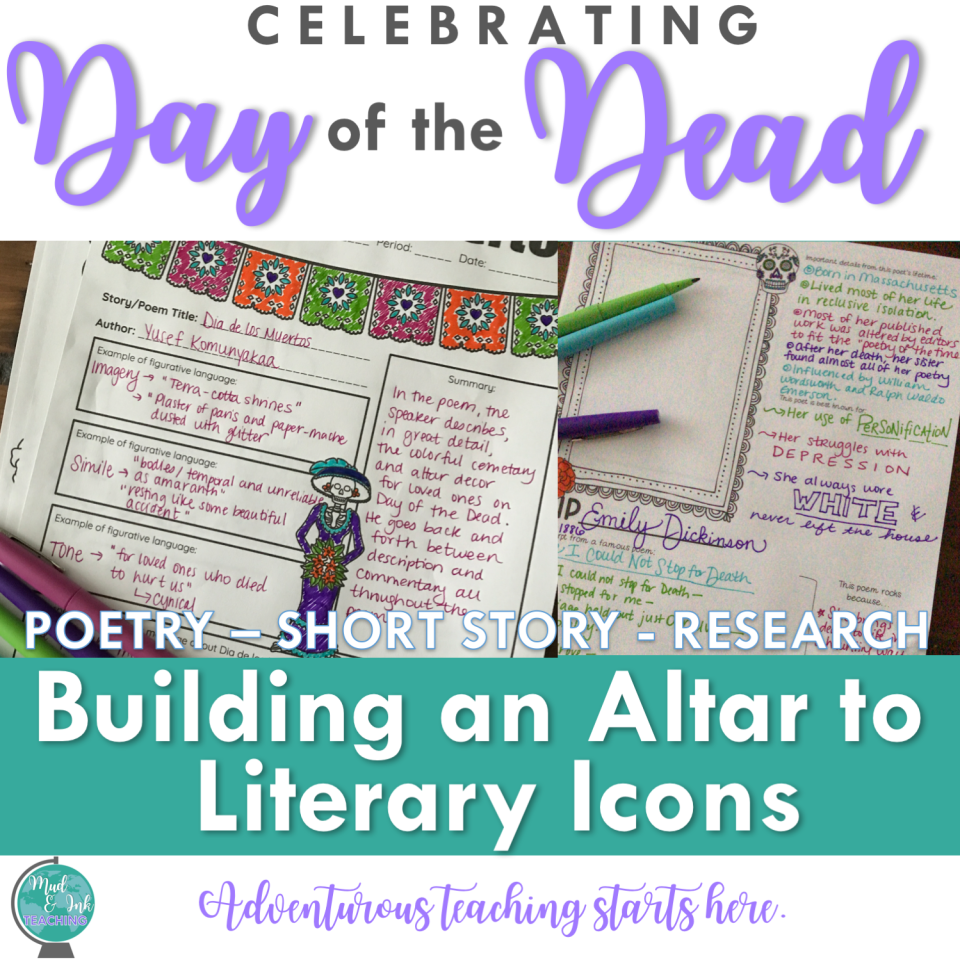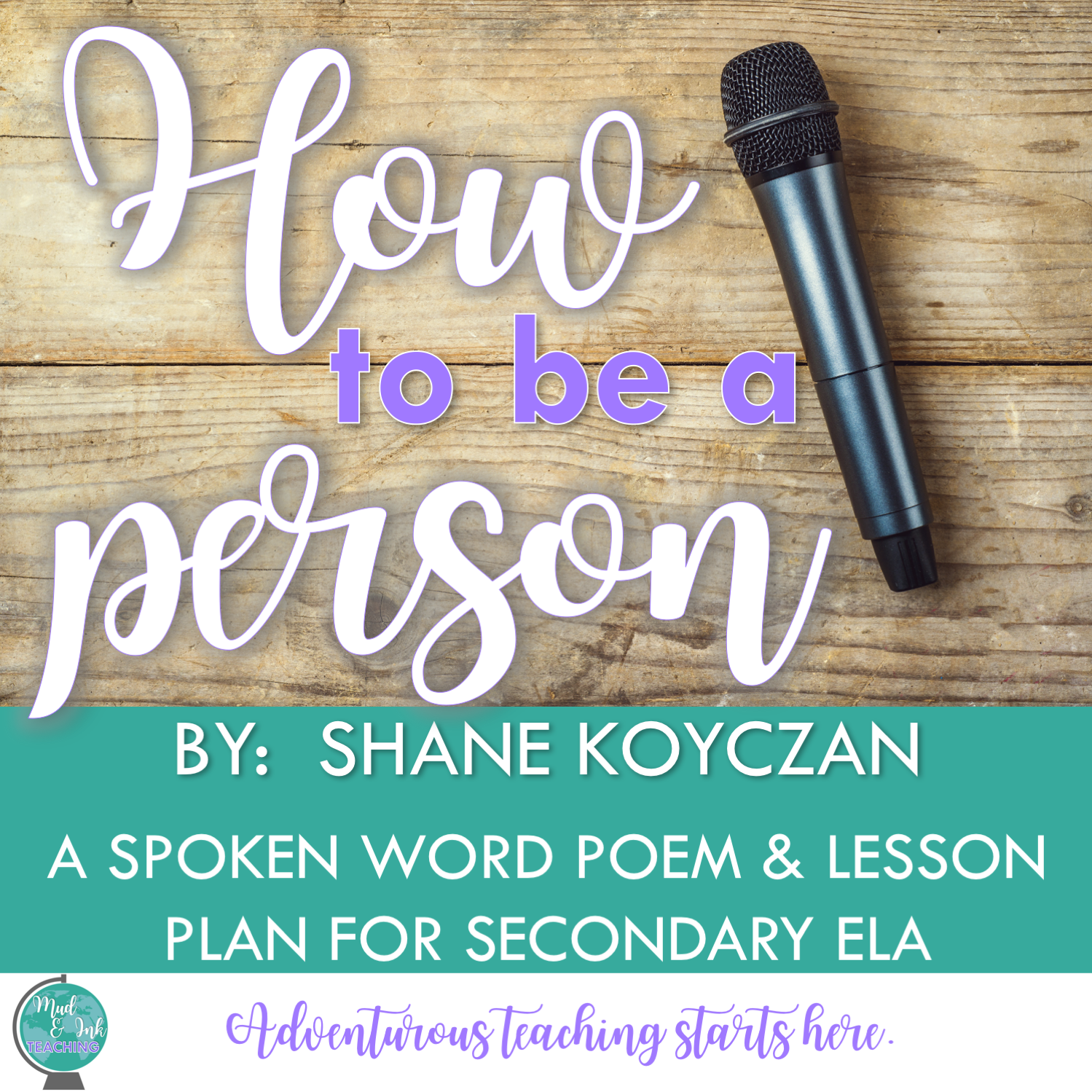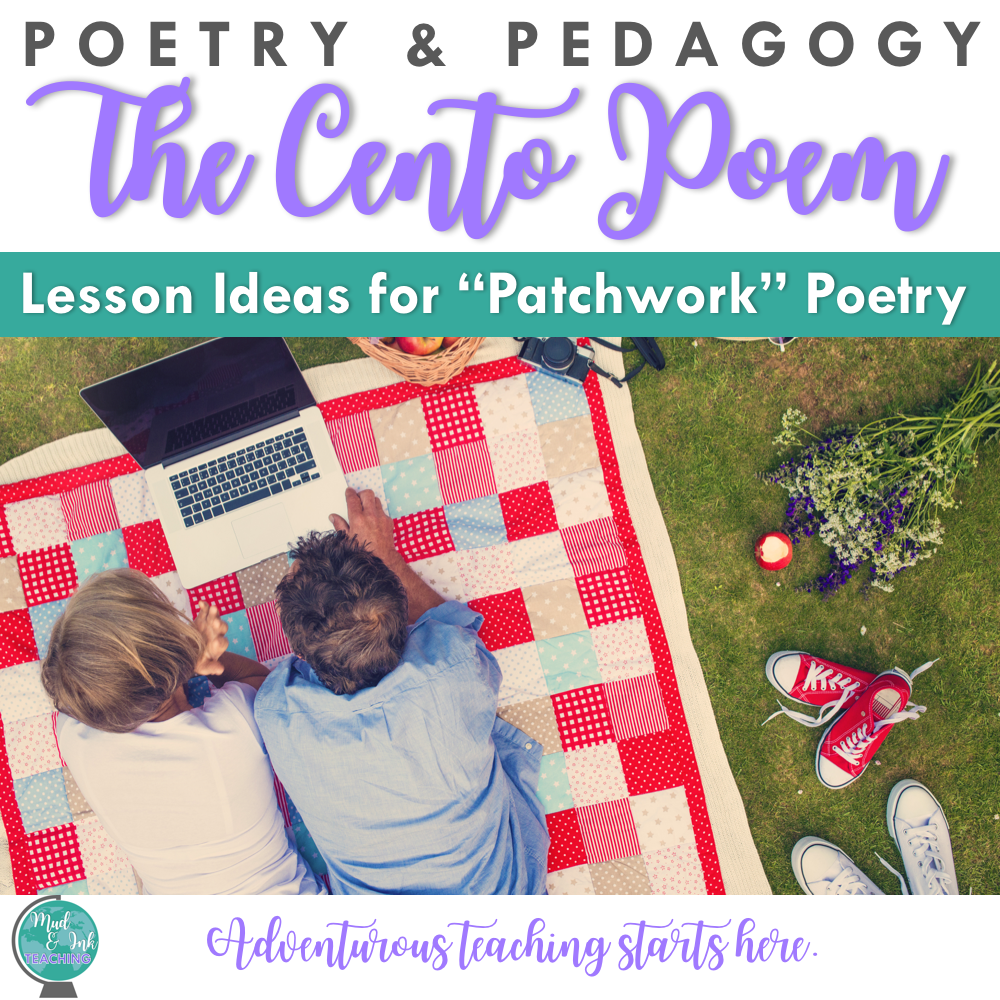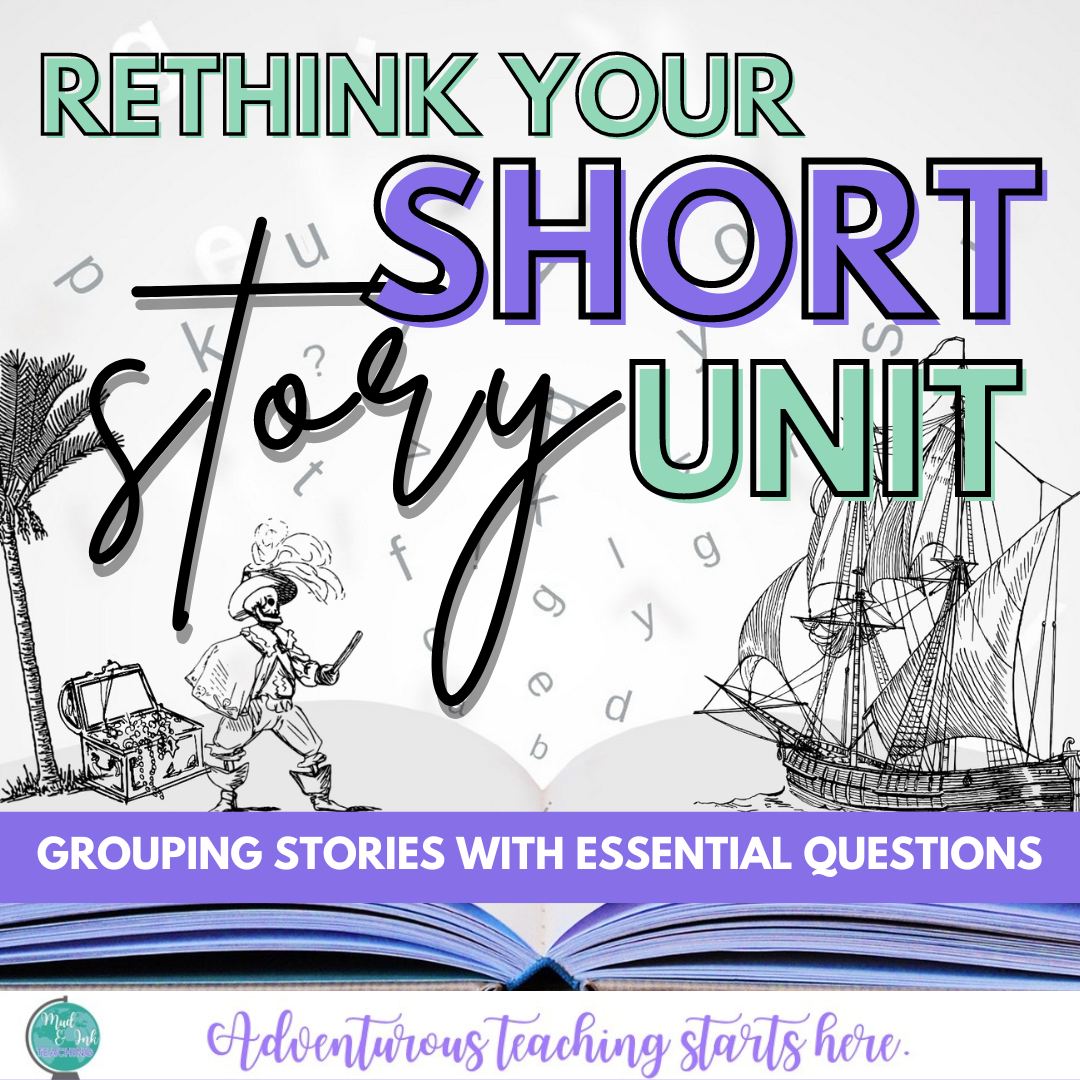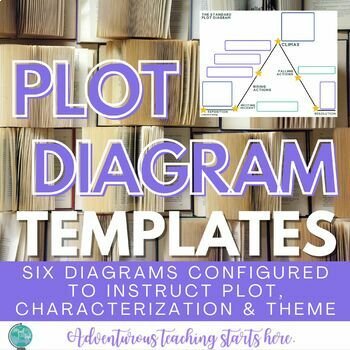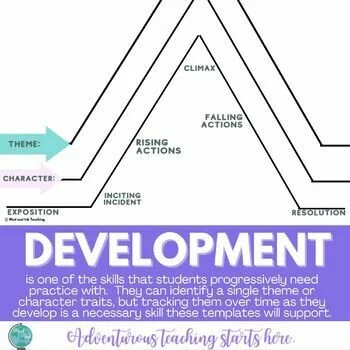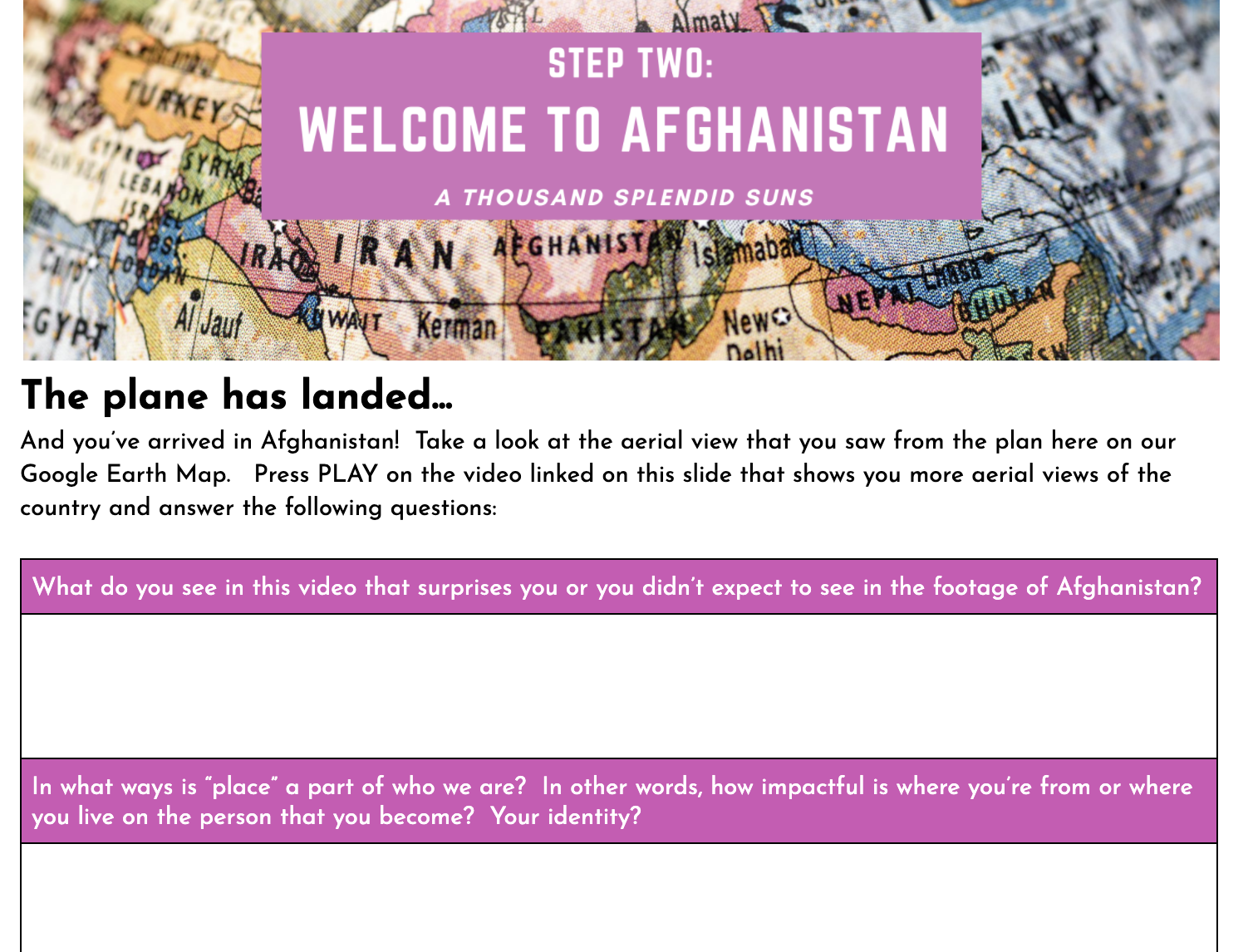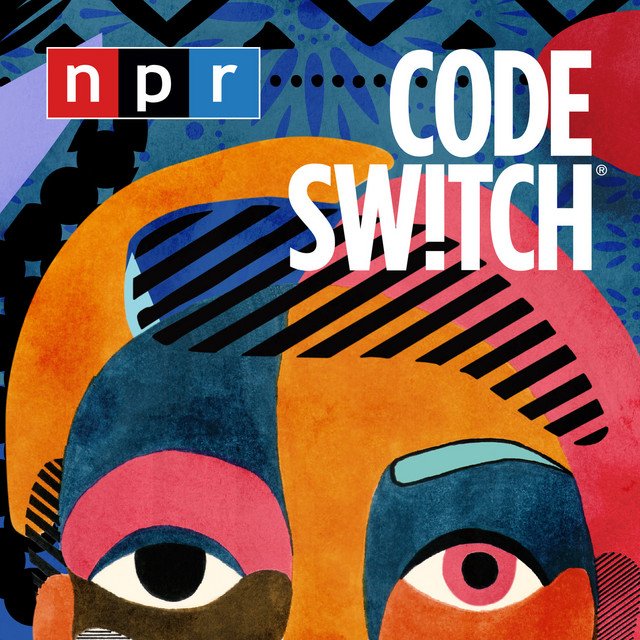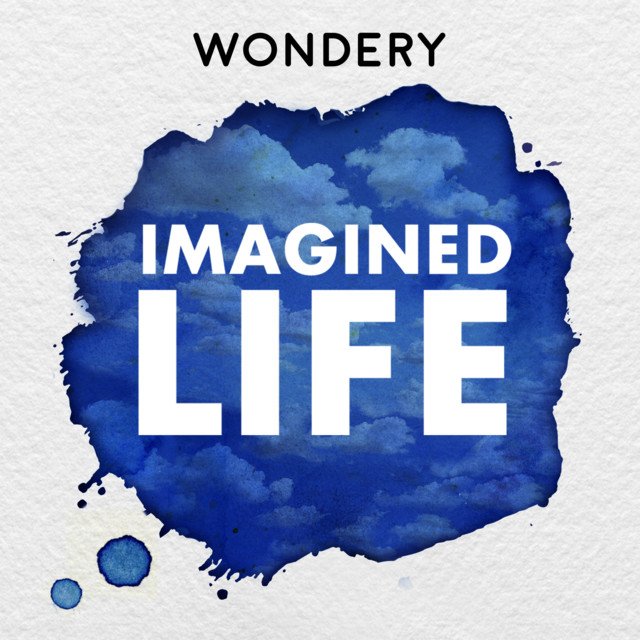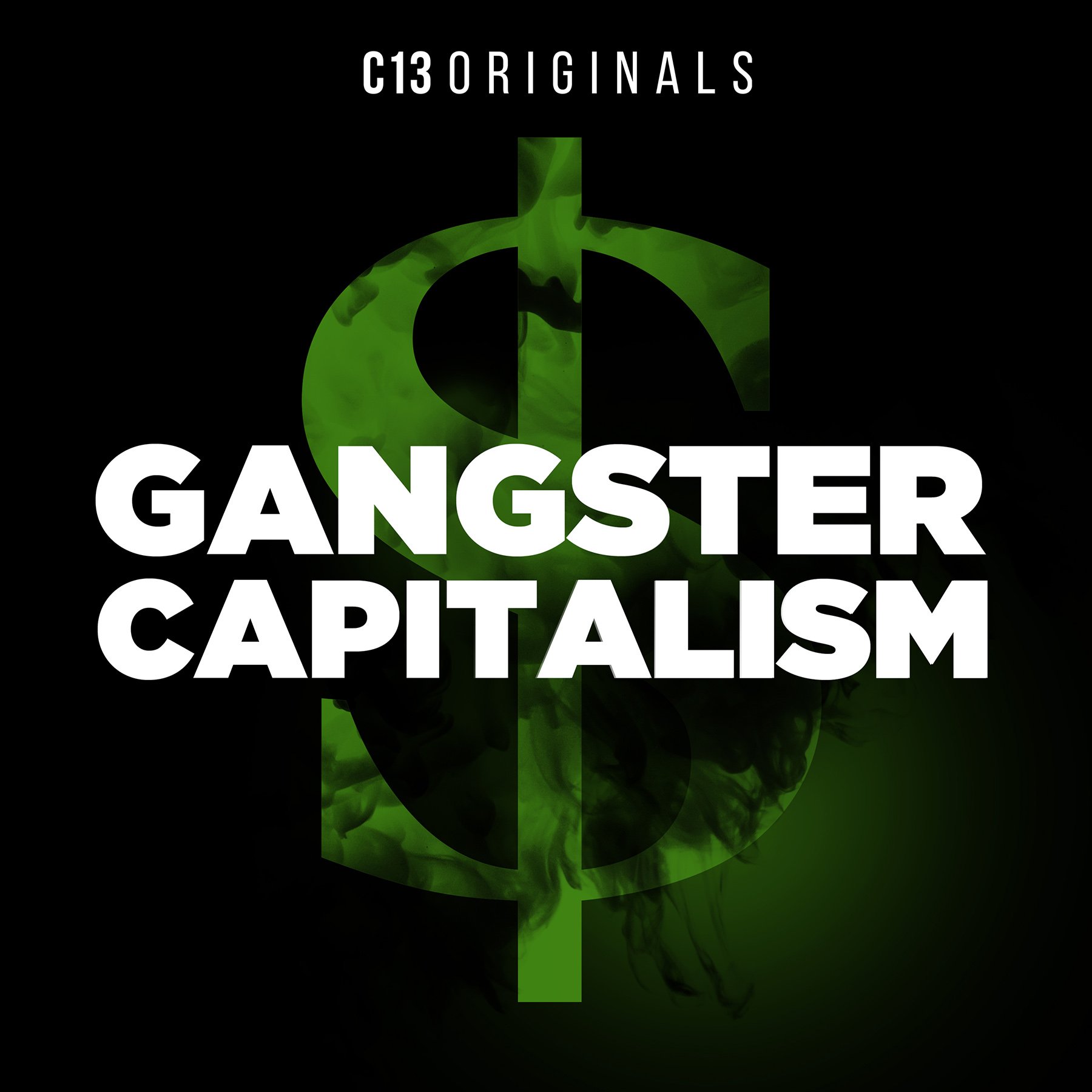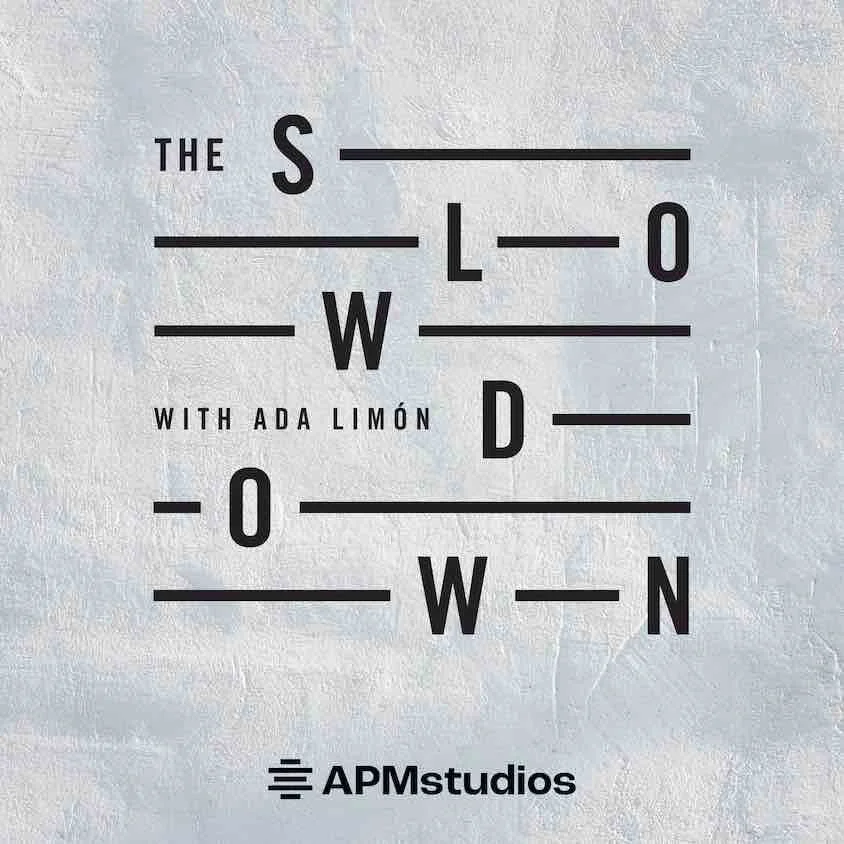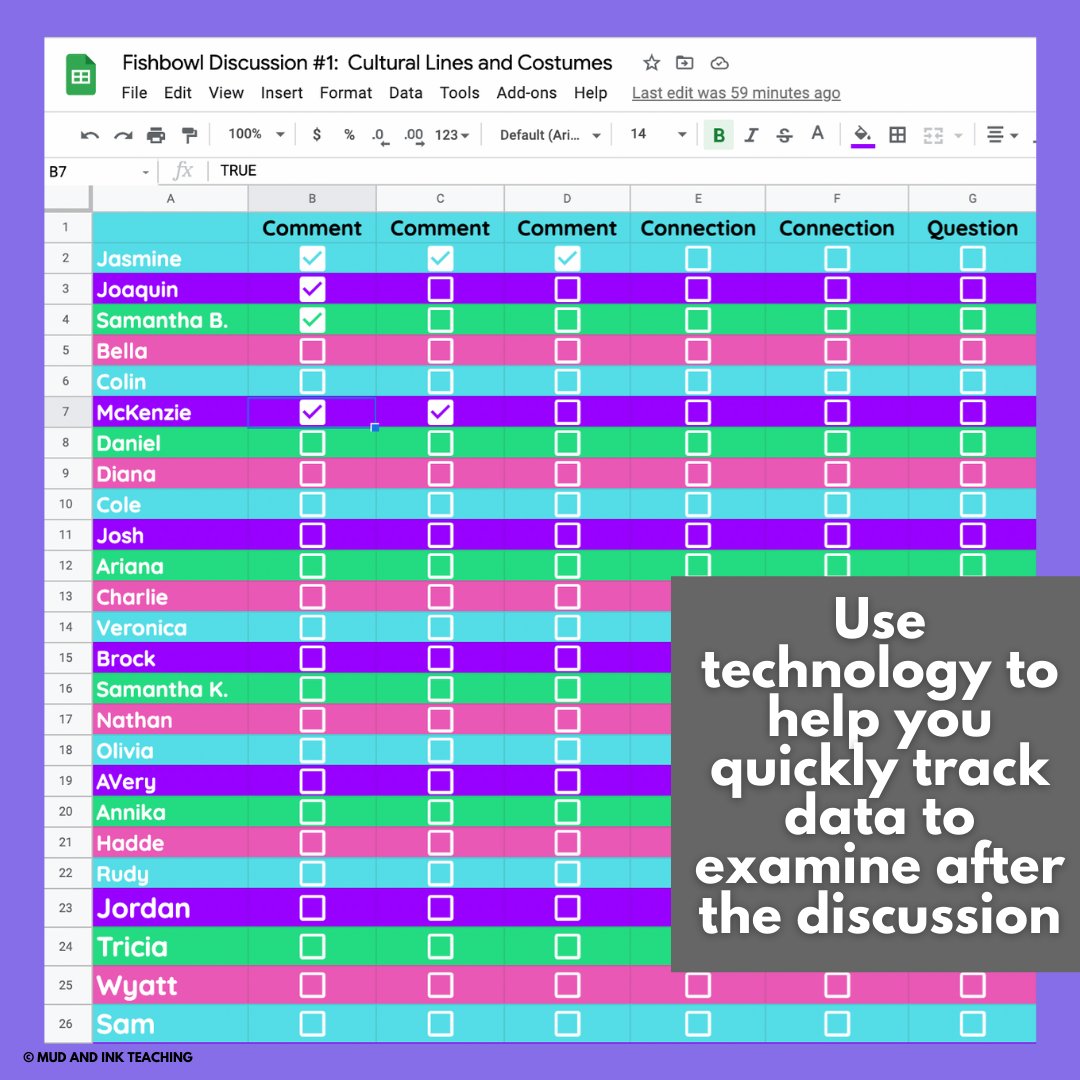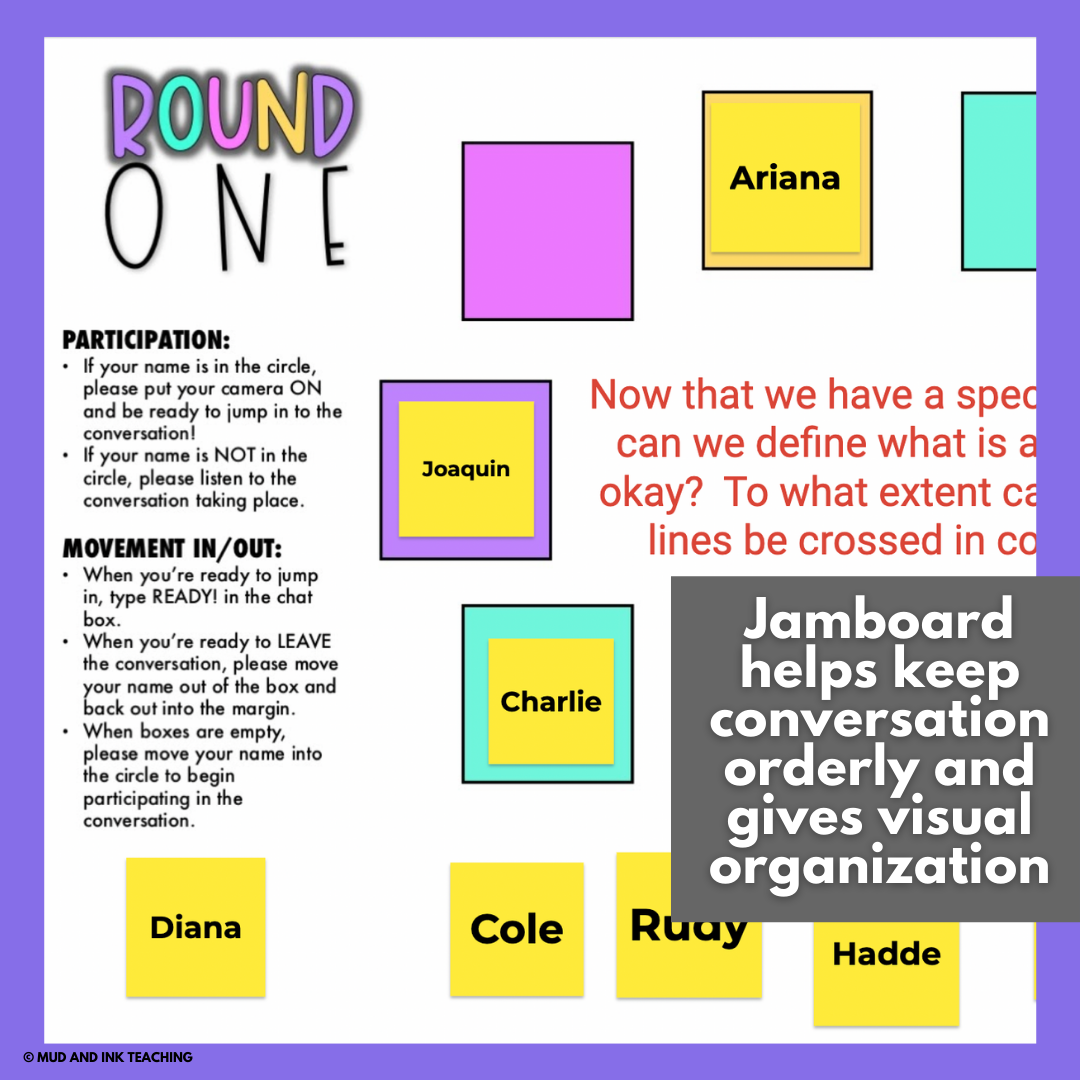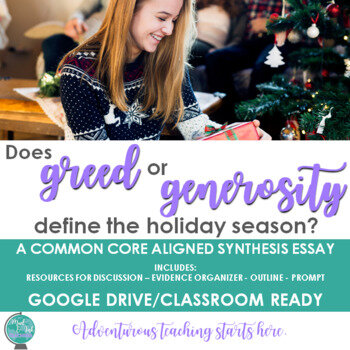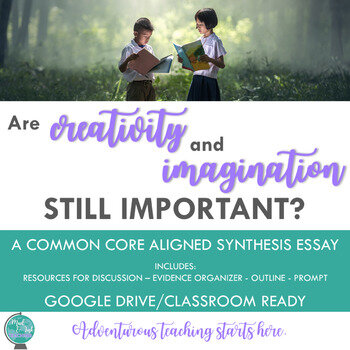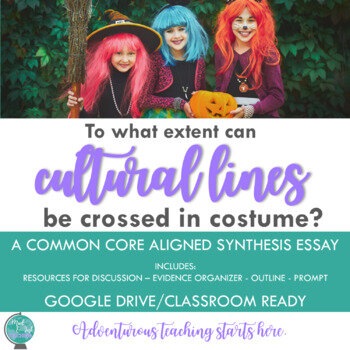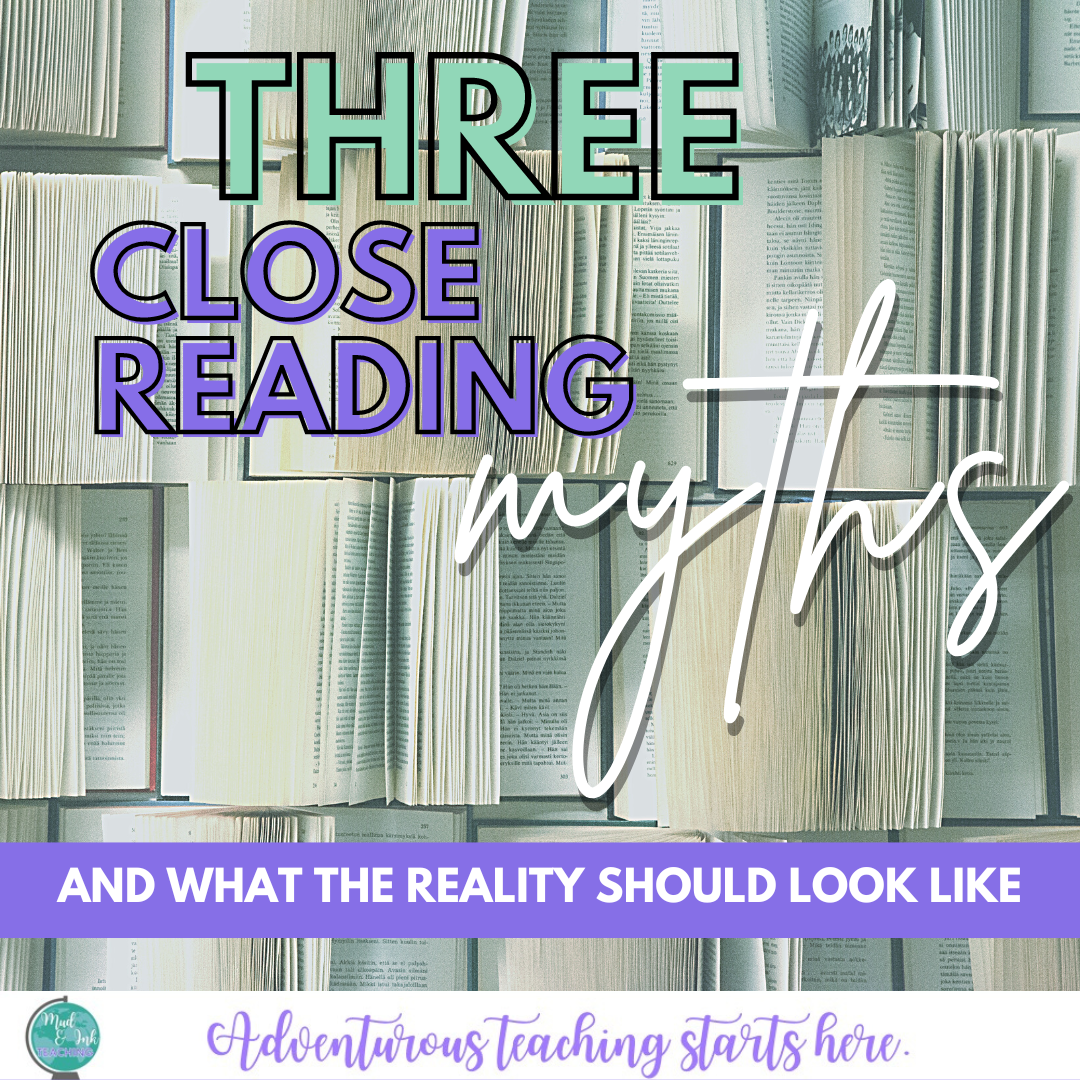
ADVENTUROUS TEACHING STARTS HERE.
Life's Blueprint: An ELA Lesson Honoring Dr. Martin Luther King Jr.
Dr. King’s legacy is especially powerful in the ELA classroom: his words, his rhetoric, and the passion with which he speaks them is not only worthy of study in its own right, but the overlaps into our content area make the analysis of the layers of his work that much more rich and impactful. Here is a free lesson walkthrough for your middle or high school English class celebrating Martin Luther King Jr.’s birthday.
Life's Blueprint: An ELA Lesson Honoring Dr. Martin Luther King Jr.
Dr. King’s legacy is especially powerful in the ELA classroom: his words, his rhetoric, and the passion with which he speaks them is not only worthy of study in its own right, but the overlaps into our content area make the analysis of the layers of his work that much more rich and impactful.
If your experience is anything like mine, I found myself a bit stuck in trying to find something different to read and analyze in honor of his birthday. By the time students got to me, they had already read or worked through “Letter from Birmingham Jail” and “I Have a Dream”, so a few years back I set out to find another great work to study that would be fresh for students and give them a new angle and understanding of the breadth of Dr. King's work.
What's your life blueprint?
This speech is a fantastic option if you find yourself in a similar position. Take a listen below:
I created a sketchnotes activity for you to use with some other lesson plan suggestions. I'm passing that along to you as just a thank you for being here and because sharing this work is so very important and I don't want anything to stand in the way of getting it done! On a seasonal note, this is the perfect e-learning lesson if school is called off around a snowy or brutally cold MLK day (it’s happened in Chicago before!).
LISTENING WITH SKETCHNOTES
The art of the sketchnote listening activity is that it takes us away from the “fill in the blank” mentality. With sketchnotes, students can actively listen, doodle, draw, sketch, and write in a way that vibes best with their brain’s pace and what emotionally resonates with them. You can play and pause the speech for each number to give students a chance to catch up, to share out loud, or to turn and talk to a partner. It’s important to note that each of the numbered components is NOT a question, rather, they’re phrases from the speech that serve to help students see the outline of his claim at a glance. The space on the page is for them to fill in with the details, evidence, and other words that exemplify that particular portion of the speech.
COMING BACK TOGETHER
Maybe students were turning and talking at a few moments during the speech, but if they haven’t checked in yet, give them that chance. Let them process in a small group table or in pairs through each of the three components of the speech.
Next, create an opportunity for full class discussion. I like to set up a post-it note gallery walk. I place these posters at the center or top of a giant post it note. Then, students move around the room to each of these pull quote posters to:
share a connection
add on to the idea
illustrate how this looks in their mind
elaborate with more detail
When the timer goes off (4-5 minutes is sufficient), students rotate to the next pull quote poster to add their thoughts. As they move, they can bring their sketchnotes with them to reference as they think through the speech with a larger context.
Finally, once students have rotated through each of the posters, you are set up to lead a large group discussion poster-by-poster soliciting students to share their contributions and discuss the speech even further.
GETTING STARTED
I set this lesson up and made the sketchnotes for you already! All you need to do is download them below.
THE IMPORTANCE OF BIPOC LEADERSHIP
The MLK Jr. holiday shouldn’t be the first time that a person of color is celebrated, highlighted, or studied. In the North American calendar, Dr. King’s birthday falls in January, and if we’ve gone an entire semester without looking at non-white leaders and cultural icons, that’s something important to reflect on.
There are opportunities all the time to give students access to meeting and researching the lives of powerful Black American “Influencers”. Before social media culture, activists, leaders, and speakers in the Black community were working tirelessly to shape the cultural landscape of America. Here is one way that I like to do that:
I hope you found these ideas helpful and inspiring. I hope you have a wonderful week at school and happy teaching!
LET’S GO SHOPPING
22 Teacher Favorites: Poems for Social Justice
Poetry is one of my favorite vehicles to have these critical thinking discussions about social justice. The voices in poetry are so raw, real, and products of the moments from which they came. This list of 22 came from talking to teachers online about their favorites to use in the classroom, as well as my own experience teaching poetry and creative writing.
Through poetry and song, many important movements have been carried through the power of the artistic spoken word. As we work to bring critical thinking and social justice into our classrooms, we not only are providing a powerful content area for skill building but also actively working to support the social and emotional learning of our students as they attempt to figure out the complicated world in which they live.
Poetry is one of my favorite vehicles to have these critical thinking discussions about social justice. The voices in poetry are so raw, real, and products of the moments from which they came. This list of 22 came from talking to teachers online about their favorites to use in the classroom, as well as my own experience teaching poetry and creative writing.
If you’re not sure what do to with a poem, I can help you sort that out:
IDEAS FOR A THEMATIC GROUPING OF POEMS:
Study a group of poems under the same Essential Question and work on building their literary analysis skills using The Big Six
Use this list to update or supplement your poems for Poetry March Madness
Use these poems to supplement an already existing novel unit as a missing voice, a voice to add complexity, or to mirror a character in the novel
Use these poems to create a Digital Poetry Choice Board
Use these poems for imitation: read, discuss, then attempt to recreate a style, a turn, a particular poetic device, etc.
And if you’re ready for an even deeper dive into the power of poetry, I’d love to have you join us in the Teaching Poetry & Creative Writing Workshop! It’s completely virtual and asynchronous, so come in anytime and gain dozens of new ideas and insights into your own practice.
And now, on to the list! Be sure to leave a comment below with additional suggestions and your own experience teaching these poems — your work is so inspiring!
“The Hill we climb” by Amanda Gorman
This poem was hot in the spotlight for the Presidential Inauguration of 2021, but it’s power has not lessened since then. I love the versatility of this poem: study it as a poem in isolation or look at it as an argument with a rhetorical analysis angle! If you need a lesson plan for analysis, I’ve got you covered:
2. A Wreath for Emmett Till
Picture books can be an amazing way to engage students in a lesson, and several teachers have reported that this one if a brilliant overlap between poetry and social justice.
3. “This is America” from childish gambino
This one is not recommended for younger students, but if you have some older students ready to dig into both the poetry of this song and the visual experience of the music video, you’ll have one of the most engaging, important lessons of your career.
4. “LET AMERICA BE AMERICA AGAIN” BY LANGSTON HUGHES
Of all Hughes’ poems, this one was always the one that most resonated and moved my students. It’s rich with imagery and allusion and I recommend taking your time with this one — it’s not a single class period lesson.
5. “IF WE MUST DIE” BY CLAUDE MCKAY
This poem is haunting and a beautiful study in tone and theme. I especially enjoy Kevin Young’s discussion of the poem and his beautiful performance, too.
6. “CITIZEN ILLEGAL” BY JOSE OLIVAREZ
I’ve had the true pleasure of meeting Jose Olivarez back in my days of working with Young Chicago Authors and Louder Than a Bomb, and I can say for certain, this work resonates with students. It’s certainly powerful for me, but whenever I put his work in front of students, something magical truly happens.
In this stunning debut, poet José Olivarez explores the stories, contradictions, joys, and sorrows that embody life in the spaces between Mexico and America. He paints vivid portraits of good kids, bad kids, families clinging to hope, life after the steel mills, gentrifying barrios, and everything in between. Drawing on the rich traditions of Latinx and Chicago writers like Sandra Cisneros and Gwendolyn Brooks, Olivarez creates a home out of life in the in-between. Combining wry humor with potent emotional force, Olivarez takes on complex issues of race, ethnicity, gender, class, and immigration using an everyday language that invites the reader in. Olivarez has a unique voice that makes him a poet to watch.
7. “NOT AN ELEGY FOR MIKE BROWN” BY DANEZ SMITH
This is a beautiful and gut-wrenching piece about the disproportionate attention paid to the death of Black Americans. It’s very short and would work nicely in a choice board where students could tackle it independently.
8. “ODE TO THE ONLY BLACK KID IN THE CLASS” BY CLINT SMITH
This and so many more from Smith’s anthology Counting Descent deserve a spot on this list and in your curriculum. In fact, Clint Smith’s name should be on the tip of every ELA teacher’s tongue when recommending poetry about the Black American experience.
Smith explores the cognitive dissonance that results from belonging to a community that unapologetically celebrates black humanity while living in a world that often renders blackness a caricature of fear. His poems move fluidly across personal and political histories, all the while reflecting on the social construction of our lived experiences. Smith brings the reader on a powerful journey forcing us to reflect on all that we learn growing up, and all that we seek to unlearn moving forward.
9. “NATIVE TONGUE” BY MICHA BOURNES
This poem is a fascinating look at the colonization of language and othering that’s been done to Black speech.
10. “ORAL TRADITION” BY WILLIAM NU’UTUPU GILES & TRAVIS T.
William Nu’utupu Giles is an afrakasi Samoan writer, and this poem focuses on the passing down of stories and traditions through spoken word for thousands of years.
11. “SOMEWHERE IN AMERICA” FROM BRAVE NEW VOICES
In this moving poem about censorship and government control, the speakers critique the contrasting experiences of America’s youth from the books they are allowed to read in school to the histories that are not taught.
12. “BLACK GIRL MAGIC” BY MAHOGANY BROWN
In this poem about belonging and experiencing othering, Brown examines what “Black Girl Magic” looks like through her eyes.
13. “ ELEPHANT” BY JOAQUIN ZIHUATANEJO
This poem focuses on the Rwandan Genocide of the 1990’s and compares the experience of a mother losing her child to that of an elephant holding her lifeless calf. This poem is packed with emotional language surrounding a lesser taught historical tragedy,
14. “SECOND ATTEMPT CROSSING” BY JAVIER ZAMORA
In this emotional poem, Zamora depicts the immense fear, uncertainty, and loss one feels when crossing over the US border illegally.
15. “GLORY” BY COMMON
From the movie Selma, this anthem speaks of an undying hope felt by those fighting for equality during the Civil Rights Movement despite great violence and discrimination against them.
16. “BULLET POINTS” BY JERICHO BROWN
In this poem, Brown explores hate crimes in America and the violence against Black people at the hands of law enforcement.
17. “TO THIS DAY” BY SHANE KOYCZAN
Shane Koyczan, a powerful spoken word poet, delivers a close look at the lasting effects of bullying in one’s childhood.
18. “WHAT CAN A POEM DO?” BY DARIUS V. DAUGHTRY
In this poem by Darius V. Daughtry, he explores the extent to which words, and more specifically poetry, have the power to cross borders and save lives. This poem is rich with figurative language and beautiful metaphors.
19. “CHINESE 101” BY SUN LUU
Luu describes his poem with this beautiful introduction:
“An ode to my mother, to my mother tongue, and all who've given me the opportunity to exist today. This is for all those who've tried to ostracize my people, who've tried to diminish the Chinese language, and have silenced and made caricatures of Asians in America. Here, I take back my language. I take back my culture. And find the voice to speak.”
20. “MISS AMERICA” BY RAMYA RAMANA
This poem is a response to racist comments and remarks after the announcement of Nina Davuluri, an Indian American woman, as the winner of Miss America in 2014.
21. “BROWN BOY, WHITE HOUSE” BY AMIR SAFI
Safi tells the story of living in post-9/11 America and dealing with the racial stereotyping and profiling he experienced.
22. “Passive Voice” by Laura Da
In this short but powerful poem, Da draws attention to the use of passive voice when describing the history of Native American culture.
EVEN MORE RESOURCES
Unit Makeover: The Short Story Unit in Secondary ELA
Short story units have the potential to deeply inspire and impact learning with students, but if the approach is disjointed or lacking any sort of alignment, these units can feel like flops. Here are the ways that I craft meaningful, engaging, and interesting units to highlight the short stories that we love (and a few more that we should add to the rotation!)
Unit Makeover: The Short Story Unit in Secondary ELA
When is the last time you sat down for a meal where your server recommended a very specific bottle of wine to match the meal you were considering on the menu? The perfect Argentinian Malbec to compliment the perfect marbled ribeye. And when is the last time you tasted that symphony of flavors? The melting, fatty salt of the meat on your tongue is followed by the gentle swirl of the deep red wine just after.
Maybe you’re a vegetarian and ready to never come back here and read another article from me again, and I understand (this is not the first time that I’ve used a metaphor about meat. Hmmm…), but if you’re willing to hear me out, here it is:
Disjointed experiences are fine, but intentionally, purposefully blended ones are so much more memorable.
This is precisely how I feel about unit planning and especially the notoriously predictable plan that every English teacher since the dawn of time seems to design: UNIT 1 - SHORT STORIES.
THE DISJOINTED SHORT STORY SCENARIO
The idea for this unit seems logical on paper: start the year with some shorter texts to warm back up, review everything students need to know for the year coming up, and presto! Ready to take on the year. But after experiencing this myself and talking to hundreds of other teachers, there are a few notable problems:
PROBLEM 1: Lack of connection
Short stories don’t naturally connect to one another just because they are short stories. So when we begin these units thinking about the skill review component, we are often blindsided as the unit is in progress feeling like it’s clunky and lacks flow. Without the feeling of connection, these units can be difficult to navigate in terms of pacing and engagement.
PROBLEM 2: Lack of representation
The most commonly anthologized stores also tend to be Euro-centric, male-authored stories. We have a responsibility to do better for our students and to have their own voices, stories, backgrounds, and experiences represented and included in everything we do. This means branching outside of the short stories most frequently recommended by text book companies and doing some of our own research to find new, fresh voices.
PROBLEM 3: Lack of variety
One teacher wrote to me saying: “I do run into trouble when I try to use short stories that are available on CommonLit. When I've tried to use them in the past--some are amazing short stories, like "The Landlady" and "The Intepolers"--the kids complain that they've already read them! UGH”
Does this sound familiar? Since starting the year this way is so popular and databases like CommonLit have come around, teachers sometimes find themselves going to the same places for ideas and then repeating stories.
PROBLEM 4: Trying to cover too many skills
Sometimes the nebulous goal of “reviewing literary terms” stretches student focus too thin. Attempting to use one single unit to cover a dozen or more terms ends up giving us more attention to breadth rather than depth.
Specific EQ Unit & Text Set Pairings:
To solve many of these problems with the traditional short story unit, I recommend implementing an Essential Question to drive the unit. Short stories need to be contextualized, and using an Essential Question connects the dots and creates meaning. The art of writing an essential question takes into consideration three key components: text(s), themes, and skills. Essential questions should drive genuine curiosity and be exciting for students to explore, discuss, debate, and return to throughout the year.
Below, I’ve drafted a few examples of EQs that could theoretically be used at the start of a school year. You’ll notice a few things:
The question anchors the unit. From introducing the question to assessment, the question is the driving force that connects all texts and activities.
Instead of teaching short stories and a variety of random literary terms, the unit is cohesively driven by a more narrow focus.
The EQ gives direction for the unit without being prescriptive. The suggestions I have here are flexible and adaptable to different grade and difficulty levels.
In each of the example units below, I’ve provided a mixture of the most commonly used short stories that you may have from anthologies or prescription curriculums blended with new ideas, short film, music, and other genres to further address the complexity of the EQ. Be sure to check out Episode 107 of the Brave New Teaching Podcast to see how this method was applied in Marie’s class!
Here are a few example ideas to get started:
Example #1: Connected by a skill/standard
Unit 1: Is conflict more likely to make our lives better or worse?
Skill Focus: The shape and arc of stories
Plot diagram components (with emphasis on conflict)
Exposition, inciting incident, rising actions, climax, falling actions, resolution
Vonnegut’s The Shape of Stories
Internal VS External Conflict
Three classical types of conflict: “man vs man”, “man vs. nature”, “man vs himself”
Text Set:
Buzz Lightyear Internal Conflict - You are Just a Toy: Scene 1 & Scene 2
All American on Netflix Episode 1
Assessment:
Skill Focus: Cold Read & Written response based on conflict
EQ Focus: Synthesis argument writing answering the EQ (utilize personal experience and texts from the unit to answer EQ)
Example #2: Connected by genre
Unit 1: To what extent does gothic fiction reveal the human condition?
Skill Focus: The elements of gothic fiction
Author’s use of tension
Author’s use of tone/mood
Setting
Text Set:
Excerpt from Mexican Gothic by Sylvia Moreno Garcia
Various scenes from The Phantom of the Opera
Assessment:
Skill Focus: A project-based assignment where students analyze the connection between tension, mood and setting (a recreated scene and written analysis; a living tableau; an artistic interpretation)
EQ Focus: A literary analysis writing that hones in on one of the stories and the gothic elements that reveal the human condition
Need to teach plot elements?
Example #3: Connected by another genre
Unit 1: How does dystopian fiction use the present to predict the dangers of the future?
Skill Focus: The elements of dystopian fiction
Characteristics of a dystopian protagonist
Author’s use of tone/mood
Setting
Imagery
Text Set:
“There Will Come Soft Rains” by Ray Bradbury
“The Lottery” by Shirley Jackson
“Harrison Bergeron” by Kurt Vonnegut
“The Ones Who Walk Away from Omelas” by Ursula K. LeGuin
Assessment:
Skill Focus: Cold Read & Write: How does the author’s use of genre elements / setting / imagery / use of tone/mood in order to warn about the dangers of the future?
EQ Focus: Research project: select a present problem and predict the dystopian future to come from this issue
Example #4: Connected by a theme
Unit 1: Which is more impactful in a child’s coming of age: the influence of family or the physical environment around them?
Skill Focus: Elements of coming of age genre
Setting
Characterization (direct & indirect)
Text Set:
Assessment:
Skill Focus: One Pager - Choose one character to place at the center. Surrounding the character, add evidence of coming-of-age moments, setting, etc. that have influenced their development
EQ Focus: Synthesis Argumentative essay responding to the EQ using the short stories from the unit
Example #5: Short Stories Reimagined in Fairy Tales
In episode 107 of the Brave New Teaching Podcast, I chat with my cohost Marie Morris about the process of tackling a unit makeover with short stories. Listen in to see how we resolved so many of the problems (at the top of this post) and built a Fairy Tale Unit that completely revamped the level of engagement while still tackling all of the skills that mattered the most.
No matter how you tackle your unit makeover, consider the power of that Essential Question to give the context your unit needs. I’d love to hear how you tackled your own makeover, so be sure to leave a comment below!
TRY AN EQ ADVENTURE PACK!
These units are packed up and ready to teach! They are seamlessly aligned with a juicy Essential Question, supplemental texts, and plenty of templates to use in tandem with whatever short stories or novels you have on hand. Check them out right here!
LET’S GO SHOPPING…
10 Back to School Learning Station Ideas for Middle and High School
One of the best ways to start your back to school lesson planning is with a stations activity. Gone are the days of reading the syllabus out loud, and right in front of us are the days of interactive, meaningful, and focused activities. Get your students started in groups and take them through an orientation to your room, your expectations, and the school year ahead. Here are 10 ideas to get you started.
10 Back to School Learning Station Ideas for Middle and High School
For several years now, teachers have joined the mission to intentionally create a first day and first week of school that are reflective of the kind of classroom culture and environment that they want to create for the whole school year. Gone are the days of reading the syllabus aloud to students and droning on for days at a time. And one of the most popular ideas that has grown to replace these teacher-centered practices is the use of back to school STATIONS. It’s been a cornerstone lesson in my First Ten Days of School practice for the last decade.
Stations as an instructional strategy is relatively straightforward. A certain number of tasks that take a similar amount of time to complete are predetermined by the teacher and become the “stations”. Then, students are broken up into the same number of groups as there are stations. Using a timer, students work at their assigned station for the allotted time, then with the timer, switch to the next station for the next task. This is a great way to begin the process of teaching your routines around this instructional strategy -- trust me, your October self will thank you for starting routine practice early and often!
With back to school season always having a slew of odd ball housekeeping tasks to accomplish, stations is a great way to keep the pace of class moving, get students out of their seats, and begin the process of getting to know each other based on the small group they’re moving.
Syllabus & Questions for My Teacher
After making the switch from a paper to a digital syllabus, I’ve been able to navigate getting the important information it includes in front of both students and parents. With a digital syllabus, I can “assign” looking through it the night before stations, and then, in this station, ask students to revisit the syllabus and on an index card, leave questions and comments for me at the station that I can answer FAQ style in upcoming days. You could also give the students at this station a syllabus “quiz” in the style of true/false or multiple choice.
A copy of my digital syllabus template is available inside my exclusive course for teachers: The First 10 Days: The Complete Back to School Toolkit.
Establish a “Brave Space”
Station time is also a wonderful opportunity to set up intentional experiences for students to see and participate in your classroom expectations. One simple, yet powerful, station idea is to use a section of your room close to a whiteboard (using my FAVE markers) or giant post-it, and write on the board BRAVE SPACE. Explain in the directions for students to write around the word with definitions and examples of what a “Brave Space” should look and feel like in the classroom. I make sure to take a picture of each class period’s answers to use later for debriefing and adding to my digital syllabus under my “Expectations” tab.
FAQ QR Code Classroom Management System
Another way to use your stations activity is to introduce your students to various functional spaces in your classroom and give them a chance to be oriented to how they work, I speak about this at length in episode 58 of the Brave New Teaching podcast as we discuss the importance of functional classroom decor. For me, one of the most important spaces in my room is my FAQ QR Station. This is the place in my room where students come to get their frequently asked questions answered…by a video, not by me. Because we can answer questions about late homework, going to the bathroom, and other policies for only so long before we want to pull our hair out, right? So instead of answering these questions again and again (in October and November, especially), the QR code does all the work for me! This is how I prioritize functional classroom design over splurging at the Target Dollar Spot all summer long..
All About Me Student Survey
At the start of the school year, there’s quite a bit of information that I want to know about my students. Some I want to learn through conversation, but much of it I want to have to refer back to as the year progresses and I see where students are finding strength and struggle. I designed an All About Me Student Survey using Google Forms that I’ve used for years and I use this station to give students time to fill it out rather than making it “homework”.
Student-Created Classroom Decor
Typically each year I try to make one of my stations artsy crafty. The quick little project is usually connected somehow to one or more of the following: my classroom theme, something bookish and Englishy, something connected to authors we’ll study, etc. I love doing these things, but don’t have a lot of original ideas of my own, so I scour the internet for ideas! Here are a few things I’ve done in the past that have been fun and great for a quick station:
Blackout poetry on a random dictionary page: cut into triangles and closepin them to twine for a classroom banner
Contributions to a door decoration
This wreath but with different clipart
A collaborative poster of different sorts
Six Word Memoir
These can be used ANY time of year, but at the beginning of the year, six word memoirs serve as a quick and easy way to get to know students AND see how their writing brains work. Narrowing down their life story to only six words offers powerful insight into how they see themselves and how they creatively and critically approach the writing process. Since the station time might be too short to fully think this out, you might ask for a draft at this station and revisit them for a final revision later in the week.
Create a name plate/Name voice recording
Learning student names is a paramount priority when beginning the school year, but also something that can be very boing for other students to watch us struggle through. Instead of going through the attendance roster every day trying to learn names, use a station to have students create name places and even record a sound bite of their accurate name pronunciation! I show you how to easily do this in this blog post. All you’ll need for the station is paper and markers for the name plate and a few chrome books with tabs open to Vocaroo.com.
Classroom Library Tour
If you are an ELA teacher, another classroom space that you most likely need to share with your students is your classroom library. If you have a system for checkout and returns, if you have a routine associated with first chapter Friday, or just generally want students to begin perusing teh books on your shelves, make this an exploratory station! My classroom library is on a rolling cart: it’s a rotating “best of the best” system and the majority of my books are housed on a database that students access through QR code. Using this as a station during back to school give students a chance to explore that without a time-consuming overview from me and puts the ownership and focus back on the students as they begin that exploration on their own.
Take What You Need Station
Another classroom space that matters to me in the classroom is my Take What You Need station. This is an area by the front of the room that houses all of the little odds and ends of things that students are always asking for: breath mints, hand lotion, dry shampoo, gold star stickers, and more. I keep some coloring pages for students who need time to unwind when they’re feeling stressed, blank note cars to write a hand-written note to a friend, and more rotating goodies as needed.
Goal Setting
Fresh starts with a new semester are the perfect time for students to do some serious and some light hearted goal setting. I like using these one-pager templates as a station where students can do fun goal setting and add to the page as the semester continues. I have them choose three sections that are together, record the date, and share the goal. They can illustrate them as they like! As we move through the year, we revisit this template and add more and reflect on the things written at earlier stages in the semester.
I hope this year, back to school learning stations hit the trifecta for you: establishing routines, building relationships, and setting the bar for rigor. I’d love to take you through my full first ten days of school in my course when you’re ready. I’ve got every lesson, the philosophy behind each step, and a digital drop down lesson planning calendar all inside just waiting for you! Take a peek inside right here…
Happy back to school, everyone!
Getting Books with LGBTQ+ Protagonists into the Hands of All Students
Having your shelves stocked with LGBTQ+ protagonists and stories is great, but if students don’t know they’re available, don’t have a safe time to check them out, are intimidated by the cover, or simply don’t feel comfortable checking the books out, then the diversity of the library doesn’t really matter! Here are five steps to take to make sure those wonderful books actually make it into the hands that want them and need them.
This is a post from guest teacher-author John Rodney.
Getting Books with LGBTQ+ Protagonists into the Hands of All Students
Many teachers are creating LGBTQ+ inclusive classroom libraries that speak to the many identities of their LGBTQ+ students. Teachers are seeking out stories that feature LGBTQ+ protagonists in diverse storylines across genres. They are choosing stories with care to ensure that restrictive gender stereotypes are not reinforced and that intersectional identities are represented. They are putting stories that move past LGBTQ+ trauma on their classroom bookshelves.
Teachers are doing all this amazing work, and yet, despite all of this, the books remain on the shelves untouched. There are many potential reasons why students are lining up to check out these books. I want to give some steps that teachers can take to help get books into the hands of students which is exactly where we want them!
#1: Advertise. Advertise. Advertise.
Books featuring LGBTQ+ protagonists should not be separated from other books. They should be put alongside all the other books for young readers, LGBTQ+ and non-LGBTQ+, to discover and enjoy. They should be organized however that teacher may organize their library: by genre, alphabetically, etc.. This is an important symbol to students that these characters and storylines are just like every other character and storyline and deserve to be read and enjoyed. This seems like a great idea, doesn’t it? It is! Now, why might this be preventing students from reading these books? One of the issues is that the students who may be impacted the most by these books don’t know they exist. They don’t know that your bookshelves are ones that have stories that feature LGBTQ+ characters in them. One way to solve this is to step up advertising of these stories and let kids know where they are if they wish to read them. Advertising is not a one-time thing. It needs to be done repeatedly throughout the school year so that when students are finally ready to hear you, they know they have options in your classroom library to explore. When you think you’ve done enough, do a little more.
There is some debate amongst teachers that perhaps there should be identifiers of the LGBTQ+ books on the bookshelves like putting rainbow stickers on the bindings, so students may find them more easily or to separate the books entirely into their own section, so students would know where to find them. I totally get this and have contemplated it in the past myself; however, in the next section, you’ll find why making an identifiable marker for LGBTQ+ books that is recognized class-wide may negatively impact the students you are trying to help.
#2: Judge the risk by the cover.
Teachers want their students to be their authentic selves. They want students to feel an immense sense of pride in who they are; however, coming out (the act of publicly identifying yourself as a member of the LGBTQ+ community) can be a very difficult experience for young people in middle and high school. In many student’s experiences there is constant taunting and teasing for those who may not fit into what is characteristically considered masculine or feminine. The straying from norms places a target on them for harsh ridicule. A student does not actually need to be part of the LGBTQ+ community to be targeted, they just need to be perceived as one.
If students are looking to explore their identity through literature, through the books on your classroom bookshelves, it needs to feel safe to them. This is where covers of books need to be considered. For a student who is just beginning to understand who they are and wishes to read about LGBTQ+ characters or for a non-LGBTQ+ student who wants to read a good book that features an LGBTQ+ protagonist, having a book with rainbows (symbol of the LGBTQ+ community), characters breaking stereotypical appearance gender norms, or characters expressing same-gender affection on the cover can feel extremely dangerous. A book with a cover that represents an LGBTQ+ protagonist could out a child (reveal their identity as a member of the LGBTQ+ community) or have their sexuality/identity questioned. They may face severe social and physical consequences from friends and family. Be aware of the risks a child is taking to pick up that book from your classroom bookshelf when selecting which books you’ll offer.
#3: Set aside time for student to check out books when there isn’t an audience.
When some students are choosing books that feature LGBTQ+ protagonists/storylines during class, they feel like the whole world is watching them. They feel like the second they touch the book with an LGBTQ+ protagonist, a siren will go off, a spotlight will be put on them, and they will be outed or have their identity questioned and ridiculed. Why would they risk it? Many times, they don’t, and the book that could really benefit them is left on the shelf unread. Building in time during the day or the week for students to come in when others are not present is something that could get a book into the hands of a student who needs it most. This should be a part of the schedule that you create for your students so that any student can take up this opportunity.
#4: Celebrate LGBTQ+ characters, storylines, and authors.
Many ELA teachers find ways to try to engage students to inspire a life-long love of reading. They find ways to expose students to stories and genres that they normally would not gravitate to and create a curiosity within them to read. Be deliberate with the books that you are choosing for these activities; include LGBTQ+ protagonists and authors.
If you are performing “First Chapter Fridays” in your classroom, choose a book that features an LGBTQ+ protagonist. Project the cover of the book for the students to see along with a picture and brief biography of the author. Make sure to identify the LGBTQ+ identity of the author, so students understand this part of their identity.
If you are doing a “Book Tasting,” include a variety of books featuring LGBTQ+ characters and storylines across genres for the students to read and try out.
These types of activities give LGBTQ+ students and non-LGBTQ+ students opportunities to discover stories they may want to read, and it gives them a sense of pride seeing storylines fromt communities they, friends, or family members are a part of. This could make kids aware of stories open up their minds, and increase the rates at which books are checked out.
#5: Normalize the reading of LGBTQ+ books by non-LGBTQ+ students through classroom activities.
An idea that many young people have is that if a student reads books with an LGBTQ+ protagonist, the student must be queer. They ask themselves:
Why would a student read a book about a queer/gay/transgender person saving the world in a science fiction book when they could just read a “normal story” with a straight person doing it?
Why would a young person read a same gender love story when you could just read a “normal love story”?
Why read an autobiography about a LGBTQ+ person when you could read about a straight person?
This mentality can be combatted by exposing and normalizing literature by LGBTQ+ authors featuring LGBTQ+ protagonists being read by every student in the classroom.
Identifying theme through picture books? Use one with an LGBTQ characters.
Reading circles? Provide options which feature LGBTQ+ protagonists.
Compare and Contrast Paragraph? Use a short story or film that features an LGBTQ+ character to serve as the basis for the assignment.
Biography Unit? Include options of LGBTQ+ people from your bookshelves for students to read and write about.
If every student in class is reading a short story or a book by an LGBTQ+ author which features an LGBTQ+ character, then it isn’t an LGBTQ+ thing. No one is a target. No one is ridiculed. It’s just normal. It’s what students in your class do. This will empower students to pick up these stories and books own their because that’s what students do in your class. They read all stories.
This list of ways to get LGBTQ+ stories into the hands of students has not been exhausted by any means. There are so many ways to thoughtfully set up systems and build classroom culture that normalizes getting books that feature LGBTQ protagonists and storylines into the hands of all students. That is where they will do their most important work. It is where they will have the most impact.
Check out some LGBTQ+ books to add to your classroom library.
The following are affiliate links from which the author will earn a small commission from your purchase
LGBTQ+ Children's Books: https://a.co/1HIU1lm
LGBTQ+ Middle Grade Books: https://a.co/geHRTkV
LGBTQ+ Young Adult Books: https://a.co/4GeELKK
MEET OUR GUEST CONTRIBUTOR:
John Rodney has been a secondary English educator for the past 15 years at both the middle and high school levels in Southern California. For inclusive practices, relatable experiences, classroom tips, and good laughs follow him on Instagram at @teachertoteacher, TikTok at @teachertoteacher, and Twitter at john_j_rodney. He would love to connect with you.
LGBTQ+ Stories Belong in Your Classroom Library
Each year teachers welcome new students to embark on amazing learning journeys in ELA classrooms. Teachers try as hard as they can to provide activities that engage students, introduce new skills, and create environments that are welcoming to all students. Here are five ways to make sure that happens for LGBTQ+ students…
This is a post from guest teacher-author John Rodney.
LGBTQ+ Stories Belong in Your Classroom Library
Each year teachers welcome new students to embark on amazing learning journeys in ELA classrooms. Teachers try as hard as they can to provide activities that engage students, introduce new skills, and create environments that are welcoming to all students.
In recent years, a question has been posed causing teachers to aim their critical eyes at their own practices, activities, and classroom environments: Is your classroom truly a place that celebrates the identities of ALL your students?
Teachers want to do what is best for all of their students, so they are reflecting more closely on what is going on in their own classrooms. They are
looking at the literature shared.
looking at the physical and culture created.
looking at the classroom library books offered.
looking at the materials prepared.
looking at the practices implemented.
Amazing teachers are thoughtfully reflecting on the question and readying themselves to take action to improve the validation of their LGBTQ+ students’ identities in their classrooms, and I’m here with your first step. There are so many ways to increase LGBTQ+ inclusivity in schools; however, I would like to provide a few steps that focus on one of the most treasured spaces in an ELA classroom: the classroom library.
When I speak to teachers about the diversity in a classroom library, they fall into two camps: ones that have LGBTQ+ books available to students and those that don’t. If you fall into the first camp, the following list is going to help you get started. If you are a person who already has LGBTQ+ books in the classroom, the list is going to help you be more conscious of the types of LGBTQ+ books you’re providing your students.
Let’s get started!
Step #1: Find books that include LGBTQ+ protagonists.
Perform a quick audit of your classroom library. If you were to randomly take 20 books off the shelf, how many of the protagonists would be members of the LGBTQ+ community? Often times, if there is an LGBTQ+ person in a story they are tokenized and used as a sidekick. Each year I commit to buying a certain number of books featuring LGBTQ+ protagonists to add to my classroom library. A diverse library doesn’t happen by accident. You must plan for it. Start researching middle grade and young adult lists that feature LGBTQ+ protagonists, read the synopses, and purchase ones for your students read and enjoy. Revisit these lists regularly for new additions.
#2: Find narratives with LGBTQ+ characters that are plot diverse, not just ones about LGBTQ+ trauma.
There are so many stories to be shared in the LGBTQ+ community. Stocking bookshelves with one type of narrative does not support LGBTQ+ students and non-LGBTQ+ students who are looking to learn about the experiences of the LGBTQ+ community. Traditionally, stories of LGBTQ+ young adults are ones where they struggle to be their authentic selves, fear lack of acceptance of family and friends, and struggle with finding where they belong in the world. These are often stories of physical, emotional, mental, and spiritual trauma.
While having some of these stories are important, having them be the only story shared on your shelves is dangerous as children come to attempt to understand who they are. LGBTQ+ protagonists deserve to fall in love, play sports, save the world, have loving families, etc. When doing your research of books featuring LGBTQ+ characters, find stories that will fill the hearts of LGBTQ+ readers and bring smiles to their faces.
#3: Find LGBTQ+ characters across all genres.
LGBTQ+ characters should be able to see this part of their identity across all genres.
They should be in faraway galaxies saving the universe.
They should be trying escape the ghosts in a haunted house.
They should be traveling back into time to keep the timeline intact.
They should have magical powers that are yielded to defeat villains.
They should be falling in love without issues of identity.
They should be helping their best friend win contests.
They should be on the courts or fields sinking the winning basket or throwing the game-winning touchdown.
They should be solving the mystery of who stole their best friend’s bike.
LGBTQ+ students should see their interests mirrored through the books we offer them in our classrooms and non-LGBTQ+ students should see LGBTQ+ characters normalized being present across genres.
#4: Find books that share the stories of all the letters of the LGBTQ+ community.
If you look at what LGBTQ+ middle grade and young adult literature is readily available for purchase, the narratives heavily center stories of young, cisgender gay males. Teachers need to offer these stories; however, they should deliberately seek out stories that share the experiences of young people who identify as queer, lesbian, bisexual, transgender, non-binary, gender fluid, intersex, asexual, and questioning too. Every reader deserves to see themselves in a piece of literature.
#5: Find books that share the stories of intersecting identities.
Not only does middle grade and young adult literature center the young, cisgender gay male experience, but it also centers the Christian, white experience. It is so important for students to see that LGBTQ+ experiences span religion and skin colors. A young person can be a lesbian Muslim. A young person can be a non-binary Black person. A young person can be Asian and trans. An Indigenous person can be a bisexual young person. Teachers should seek out these middle grade and young adult stories which share the intersection of these identities. There’s no one LGBTQ+ story or experience. The more stories and experiences that can be shared, the better for all the student in the classroom.
Bonus Step (but an important one): Find books that don’t reinforce the binary/limits of gender or gender expression.
In middle and high school as students seek to explore what it means to be a young person; students often retreat into the strict ideas of girl and boy or masculine and feminine. For people who do not fall into this either or, it can be difficult to feel a sense of belonging. Find stories that feature protagonists that do not fall into these stereotypical/traditional behaviors of masculine and feminine. Find that protagonist that is unabashedly themselves in whatever gender expression they may exhibit who are leading awesome lives and kicking butt.
Building a classroom library that includes inclusive LGBTQ+ narratives will take time; however, these steps will get you started! If you are looking for a place to get started, check out the following link which has a variety of LGBTQ+ middle grade and YA stories for you to consider adding to your ELA classroom shelves.
Ready for the next step?
Click over here to read John’s next blog post that shows you HOW to get all of the great new books in your library actually into the hands of students that need to and want to read them…
Check out some LGBTQ+ books to add to your classroom library.
The following are affiliate links from which the author will earn a small commission from your purchase
LGBTQ+ Children's Books: https://a.co/1HIU1lm
LGBTQ+ Middle Grade Books: https://a.co/geHRTkV
LGBTQ+ Young Adult Books: https://a.co/4GeELKK
MEET OUR GUEST CONTRIBUTOR:
John Rodney has been a secondary English educator for the past 15 years at both the middle and high school levels in Southern California. For inclusive practices, relatable experiences, classroom tips, and good laughs follow him on Instagram at @teachertoteacher, TikTok at @teachertoteacher, and Twitter at john_j_rodney. He would love to connect with you.
4 Authors, Activists and Artists to Highlight During Black History Month
Here are four authors and artists that deserve a spotlight any time of year, but especially during Black History Month. Each has a speech, story, or TED Talk that you can share with students alongside a wide variety of units.
Take it from these student poets: Black history is American history. It's world history. It's ongoing and cannot be reduced to one month, but what February is all about is lifting up Black voices and celebrating the incredible works of Black people.
In the high school ELA classroom, this means that we have work to do to make this month special, memorable, and joyous. There is a rich literary history of Black American voices that can be showcased and I want to share some ideas with you outside of the same few voices that students always hear from.
ANGELA DAVIS
Who: an American political activist, professor, and author who was an active member in the Communist Party and the Black Panther Party (read more).
Check out : “The Gates of Freedom” a speech performed here and free lesson plan here
JAMES BALDWIN
Who: James Arthur Baldwin was an American novelist, playwright, essayist, poet, and activist. His essays, collected in Notes of a Native Son, explore intricacies of racial, sexual, and class distinctions in the United States during the mid-twentieth century (read more).
Check out: “Sonny's Blues" is a moving and important short story. This 1 hour live Zoom call is a bit long, but it's incredible PD for you as a teacher. Farah Jasmine Griffin, chair of Columbia University’s Department of African American and African Diaspora Studies, offers a close reading of James Baldwin’s unforgettable story of a jazz pianist’s struggles with his art and his addiction. And if you have a New York Times subscription, "The Discovery of What It Means to Be an American" is absolutely worth your time, and if you have the space for a novel study, you will love If Beale Street Could Talk.
AVA DUVERNAY
Who: Ava Marie DuVernay is an American filmmaker. She won the directing award in the U.S. dramatic competition at the 2012 Sundance Film Festival for her second feature film Middle of Nowhere, becoming the first black woman to win the award.
Check out: “The Power of Women”, a speech she gave at an awards ceremony with Variety magazine (short) or this other keynote address that she gave at the 2013 Film Independent Forum would be great for any speech or rhetorical analysis unit.
Jordan peele
Who: Jordan Haworth Peele is an American actor, comedian, and filmmaker. He is best known for his film and television work in the comedy and horror genres. Peele started his career in sketch comedy before transiting his career as a writer and director of psychological horror and satirical films. In 2017, Peele was included on the annual Time 100 list of the most influential people in the world
Check out: “How to Turn Fear Into Success”, a talk he gave at the Santa Barbara International Film Festival.
INTENTIONAL REPRESENTATION FOR STUDENTS
If you are all in for sharing more voices but at a loss for how to incorporate them into your regular classroom routine, try using a digital choice board. These choice boards can be used for early finishers, as bell work to start a class period, and even as a once a week lesson plan throughout a heritage month.
And if you STILL are looking for more ideas, I have a blog post featuring 9 incredible poets that deserve a place in your curriculum at any point of the year. You can check that out here! And further still, Marie and I published a podcast episode featuring some wonderful African American writers to feature in your curriculum and you can listen anytime here or on your favorite podcast listening platform.
LET’S GO SHOPPING!
Three Reasons You Should be Teaching A Thousand Splendid Suns
If you have a world literature course, or any upperclassman English course for that matter, A Thousand Splendid Suns should be in your curriculum. Full stop. This is by far and away one of my personal and my students’ favorite novels and if you’re not teaching it, you’re missing out. There are so many things about this novel unit that are perfect for skill-building and ripe for deep, meaningful discussion, but if I had to boil it down to my top three, then here they are…
*NOTE: THIS BLOG POST MAY CONTAIN SPOILERS
If you have a world literature course, or any upperclassman English course for that matter, A Thousand Splendid Suns should be in your curriculum. Full stop. This is by far and away one of my personal and my students’ favorite novels and if you’re not teaching it, you’re missing out. There are so many things about this novel unit that are perfect for skill-building and ripe for deep, meaningful discussion, but if I had to boil it down to my top three, then here they are:
ONE: THE IMPACT & IMPORTANCE OF RELATIONSHIPS
When we talk about inquiry-driven learning, we are looking for themes and concepts that students feel drawn toward. Relationships, whether they are within a family, romantic, or the bonds of friendship, are something that every student has seen through a variety of lenses. That is one of the strongest common denominators between students and the characters in ATSS. This is why I frame my unit under the essential question: Why do relationships matter?
ATSS has complicated and contrasting family dynamics. Although worlds apart from Afghanistan, my Midwestern, corn-belt students from the US found themselves surprised at how closely their own stories overlapped with Laila and Mariam. From Tariq and Laila’s heart-wrenching love story to the pain of Mariam’s childhood and marriage, there is depth and complexity to explore at every level of difficulty to match what your students are ready for.
One of the activities that I like to do is have students examine Laila’s relationships in a one-page template. This lesson does a great job of summarizing much of the early chapters in Part 2 and helps me see where students are comprehending and where they might be falling off course. The legend asks for students to observe three things: the nature of the relationship, a piece of evidence that showcases that relationship, and an issue, experience, or trauma that connects them. Using the legend, students work in small groups to identify three components of each relationship. I assign each group a different character, give them about 10 minutes to work, then we all come back together to share out and take notes as a whole group.
We also like to use this question to bring in some supplemental texts from the field of psychology. The impacts of childhood trauma, neglect, war, love, education, abandonment, separation, and bonding moments have a powerful effect on the kind of adult that child will become. We learn a lot about Laila and Mariam when examining The Attachment Theory, and, of course, students learn a lot when they think about this theory in relation to their own upbringing.
TWO: THE STRUCTURE OF CIRCULAR STORYTELLING
Of all the novels in the cannon that I’ve taught and the YA books that make it into our regular lit circle rotation, very few offer the opportunity to teach the narrative structure of circular storytelling. In the past, I’ve used the Disney film Coco to demonstrate this style and it’s a really special moment for students to see OTHER ways for stories to be told. Much of what they read has an exposition, rising actions, a climax, and a resolution far away from where the story began. But in ATSS, the story circles back to the exact place where it began and offers a unique sense of hope and closure that many stories in their experience never have.
This makes for a rich experience in analysis. One of my favorite activities to do toward the end of the novel is have students look at plot events from the beginning and the end of the story and analyze their connection. I start by giving them some movable stickers of important imagery from Part 4 on Google Slides that looks like this:
Then, I have students copy the sticker and past it into the PURPLE circle shown in the diagram below. In the green circle, students (in their own words) describe the connected imagery from the beginning of the novel. Between the two circles, students have space to provide an analysis of the connections - the effect of the circle - in a casual but powerful way. Of course, I start with an example that most would know from a popular movie from their childhood:
We finish this activity by returning to the Essential Question (as always!) and speculate: what does this all have to do with relationships, anyway? What is cyclical about our lives and the relationships that we have? Students have powerful conversations about generational experiences, beginning new stages of life and closing out old ones, and so much more.
THREE: THE POWER OF SETTING & GEOGRAPHY
I can count on one hand the number of students that can name the capital city of Afghanistan. I can also count on one hand the number of students that could point Afghanistan out on a map. Unfortunately, many of my students only have a few connections to Afghanistan — and the majority of those ideas are either stereotypical in nature or abundantly negative in their family’s military experiences.
So what do we do?
A virtual field trip to Afghanistan. Using Google Earth, my students get a two-day virtual tour of Herat, the place of the Buddha statues, Pakistan, and Kabul. Students view maps and videos, listen to interviews with Afghan people, and confront their own biases and stereotypes that they hold about the country. Any chance we get to “leave the walls” of our classroom, even virtually, has always left a lasting and powerful impact on my students (we also do a virtual field trip to London before starting any Shakespeare play!).
PLEASE TEACH THIS BOOK
A Thousand Splendid Suns is the kind of book that very few students would ever pick out as a choice read on their own. And that might be for the best — this book belongs in novel units across the world and is a comfortable and necessary jumping off point for very difficult conversations.
Teaching this book is not easy: the abuse, trauma, horrors of war, and painful experiences of loss in the novel are excruciating. But, ultimately, I believe this novel is about love. And hope. And the future. It’s a love story about Afghanistan and the resilience, beauty, and strength of its people. This story teaches us more about the power of true friendship than the pains of abuse. And while you’ll get parents and admin who complain about some of these scenes, you’ll know quickly who has read a synopsis and who has actually read the entire novel.
I hope you come to love Mariam and Laila’s story as much as I do and that you have the chance to share it with your students. Let me know in the comments your favorite reasons for teaching this novel, and if you’re experiencing pushback, let me know that, too. I’d love to help in any way I can.
LET’S GO SHOPPING
Must Listen Podcasts for English Teachers
If you’re new to the podcast world, let me give you a big, warm WELCOME! Podcasts have been a game-changer for me both for professional development and for adding new texture, voices, and perspectives to my Essential Question based units.
The curated list below is broken into these two categories: podcasts for PD and podcasts for content. Each of these will inspire you with new ideas and restore your joy and love of teaching at your core.
If you’re new to the podcast world, let me give you a big, warm WELCOME! Podcasts have been a game-changer for me both for professional development and for adding new texture, voices, and perspectives to my Essential Question based units.
The curated list below is broken into these two categories: podcasts for PD and podcasts for content. Each of these will inspire you with new ideas and restore your joy and love of teaching at your core.
PODCASTS FOR PD:
Looking for a community of teachers ready to break barriers and challenge the status quo? Join us at Brave New Teaching! Marie Morris of The Caffeinated Classroom and I adore hosting this podcast and helping teachers at every step of their journey.
These are two of our most downloaded episodes. Jump in and give them a listen!
There’s a reason Jenn Gonzalez’ podcast has over 8 million downloads — her content is challenging, brilliant, and honest. Start with this episode:
Join Amanda for a her expertise in all things Writing Workshop! As a middle school teacher for over a decade, Amanda will give you support AND ideas!
Betsy Potash just keeps churning out episode after episode full of strategies and inspirational ideas. I love this one about real-world research projects!
Looking for a teacher bestie down the hall that keeps it real? Pop in your earbuds and dial up The Educator’s Mindset!
PODCASTS FOR ELA CONTENT:
If there’s a dystopian unit in your future, it’s time you included LIMETOWN into the mix! This delightful 6-part podcast takes us through the fictional world of Limetown, a city of over 300 residents that vanished virtually overnight. No one really knows what was going on in this town (but we do know it was home to a mysterious research facility), and investigative journalist Lia Haddock is on the case. Follow along with Lia’s story as students watch their own dystopian worlds unfold in their novels. Grab my listening sketchnotes to help you through the podcast part and sit back and enjoy!
“Lore is an award-winning, critically-acclaimed podcast about true life scary stories. Lore exposes the darker side of history, exploring the creatures, people, and places of our wildest nightmares. Because sometimes the truth is more frightening than fiction. Each episode examines a new dark historical tale in a modern campfire experience.”
This episode pairs beautifully with The Crucible or the study of Margaret Atwood’s poem: “Half-Hanged Mary”. If superstition is on your theme list, give this one a listen!
With each episode of This American Life, Ira Glass looks into a slice of American life, typically through profiling a unique individual’s life. One of my favorites is “Switched at Birth”. I love to share this episode with students to talk about writing structure and tension.
This is a wonderful podcast to pair with any unit on memoir or writing — take a look through the huge list of favorite episodes here to get an idea of the huge variety of topics discussed on the podcast!
“What's CODE SWITCH? It's the fearless conversations about race that you've been waiting for. Hosted by journalists of color, our podcast tackles the subject of race with empathy and humor. We explore how race affects every part of society — from politics and pop culture to history, food and everything in between. This podcast makes all of us part of the conversation — because we're all part of the story. Code Switch was named Apple Podcasts' first-ever Show of the Year in 2020.”
Use this podcast to practice the important art of listening to other stories and experiences as we educate ourselves more deeply on the impact of race.
“Lauren Clark is a hair stylist in D.C. When a stranger sexually assaulted her in 2013, it sparked a years-long courtroom saga and a campaign for justice. Her story started The Post’s Amy Brittain on a reporting journey that has lasted for nearly three years — one that played out in the middle of a larger cultural reckoning.”
If you’re working on a unit examining the role of gender, this story gives powerful light to women who are all too often afraid to speak up and be labeled as attention seeking and not taken seriously.
“Each week of On Eyre, Vanessa and Lauren Sandler will take a critical look at the text and ask themselves ‘does this old book still have something to say in our world?’ But before we jump into the first chapter, a few questions need to be answered. Questions like: Who is Charlotte Bronte, and why should anyone (who isn't Vanessa) care about this book?”
This is the most intensive, analytical look at Jane Eyre I’ve ever found. The hosts break down the novel chapter by chapter and analyze through a lens of desire and power. This is a MUST listen for anyone who teaches the novel or is a huge, nerdy fan.
Calling all teachers of literary analysis — here is your podcast. Each season of Dissect tackles an album and analyzes each song one by one. From Beyonce to Mac Miller, the genres range widely and the analysis is pointed, clever, and enjoyable to listen to. Most recently was Season 9:
“Season 9 is dedicated to Mac Miller’s Swimming In Circles. Over 14 episodes, we dissect the music, lyrics, and meaning of Mac’s beautifully honest efforts to swim amidst the often tumultuous currents of the human experience.”
If you’re looking to broaden your own poetry arsenal or you’re working through an exclusive poetry unit, this Poem of the Day Podcast will give you and your students wonderful access to new poetry. This daily podcast has a wealth of episodes to scour through! The Poetry Foundation website has even more to explore, but this podcast just might get you back in the zone when it comes to poetry. If you’re looking to step up your poetry game in the classroom, here are 30 poems to get started with right away!
“What is it like to be famous before you’re famous? What is it like to walk in the shoes of another person? Each episode of Imagined Life takes you on an immersive journey into the life of a world-famous person. It’ll be someone you may think you know, even admire -- or maybe the opposite. You’ll get clues to your identity along the way. But only in the final moments will you find out who ‘you’ really are.” This podcast is fun to do similar to first chapter Friday or in the creative writing classroom.
“Hidden Brain explores the unconscious patterns that drive human behavior and questions that lie at the heart of our complex and changing world.”
I love using this episode when contemplating happiness and the American Dream while teaching The Great Gatsby. It gives us a great non-fiction, research-based look at happiness to apply as a lens.
If teaching the American Dream is on your to do list this year, Gangster Capitalism should also be on that list. This podcast digs into the SAT and college entrance scandals spearheaded by Rick Singer. Hear about how the wealthiest Americans work their way into college — in a much different way than those who are all working hard for it. Pair this podcast with my unit on The Great Gatsby for a rich discussion about wealth in America and how that impacts the American Dream.
Hosted by the brilliant Ada Limon, this podcast shares contextual thoughts related to a different poem each day. Episodes are rarely longer than seven minutes in length, making them easy to use in the classroom or as a starting place for homework. If you teach any YA novel that deals with the ways in which Black young men have been affected by police brutality, this poem is a beautiful pairing.
“Admissions Officers Hannah and Mark share the complex and dynamic work happening inside the Yale Office of Undergraduate Admissions. The podcast gives firsthand accounts of how officers read applications, make decisions within the Admissions Committee, and collaborate with other offices and resource centers. Yale College receives more than 35,000 applications annually for a first-year class of 1,550 students. Hannah and Mark give an inside look into the strategies and processes that enable admissions officers to attract promising applicants from around the world, consider every applicant through a whole-person review process, and build a class filled with strong students from an amazingly diverse collection of backgrounds. Recorded inside the Office of Undergraduate Admissions on Hillhouse Avenue, this new podcast pulls back the curtain to reveal some of Yale’s most fascinating and rewarding work.”
LET’S GO SHOPPING
Class Discussion: When to Stay Quiet, When to Speak Up
In order to facilitate high-quality classroom discussion, we must set up purposeful scaffolds on the front and back end of each discussion; however, in order for students to engage with the practice needed to meet these goals, we have to let the discussion happen organically and without our interference. These are the time that we stay in the background and when to speak up.
Let’s start by taking a quick poll:
Share your answer with us in the comments, and don’t forget to say WHY!
A: Fishbowl / B. Socratic Seminar / C. Philosophical Chairs / D. Online Discussion with Parlay
No matter which of the above is your jam, I think we can all agree that class discussion and the techniques we use to make them happen are all chasing after the goal of helping our students learn to have thoughtful discourse, how to talk about hard topics respectfully, and how to evolve their positions with both concession and deeper, more complex claims.
Discussion, whether it be at the beginning, middle, or after a unit of study, is a cornerstone in the pursuit of an inquiry-driven curriculum. Most often, discussions in my classroom are anchored to the unit essential question and present a series of sub-questions that are related. Students are encouraged to utilize a variety of sources to provide a variety of perspectives on the answer or solution to the question at hand. These discussions are high energy, personal. critical, political, and sometimes even emotional. And we, as educators, need to make sure that all of the pieces are in place so that the conversation can happen organically and without your constant intervention.
Let’s be clear on goals
If I had to make a master list of what I’m aiming for my class discussion to be able to do, it would look something like this:
How to listen to and trace the development of claims and arguments
Building confidence in students owning their own voices
Practice synthesizing information
Build connections between ideas and elevate them to a new layer of the conversation
To learn the difference between neutrality and open-mindedness
To engage in discourse to deepen thought; not to be right or wrong
In order to accomplish these goals, it requires us, the instructors, to set up purposeful scaffolds on the front and back end of each discussion; however, in order for students to engage with the practice needed to meet these goals, we have to let the discussion happen organically and without our interference.
When to Stay Quiet
The simple answer? As much as possible. Your goal is to fade into the background during the discussion and closely observe student interactions and listen to the evolution of the conversation as it unravels organically.
Troubleshooting in the Background
The logistics of these discussion strategies can be difficult to navigate the first few times though, so I’ve built two helpful tools that help me keep track of the discussion quickly and efficiently so I can spend more time paying attention to the content of the conversation.
Google Sheets Checkbox Tracker
Open up a new Google Sheet. Copy and paste your roster in the first column. In each additional column, use INSERT > CHECKBOX to create a clickable checkbox. You can label the columns “Comment 1”, “Comment 2”, “Asked a question”, “Used evidence”, etc. This is a simple way to track student participation without having to shuffle papers around. This task can also be assigned to a student if you are looking for ways for students to participate when they’re on an off-day. If students have access to a view-only version, they can monitor their own progress without you having to verbally remind students to speak up.
Google Jamboard
Jamboard is a unique tool that can help students keep track of who is in the circle and outside of the circle for a Fishbowl or Socratic. Using my Google Jambord templates, insert the template as the background image. Create a sticky note for each student with their first name. Give students “view only” access if you want to control the movement of students, or, leave it editable so students can move themselves inside and outside the circle. This works well for a virtual discussion or in classrooms where physically moving the desks into circles is particularly difficult.
Parlay Ideas
Parlay is an all-in-one tool that does the work of both the Google Sheets tracker and Google Jamboard. Parlay, when used for a live discussion, give students self-sufficiency and order as they navigate their difficult decisions. Whether you’re having a live discussion or a virtual one, Parlay will keep you away from logistical tasks and focused on the conversation at hand and will be delivered a data breakdown at the end of the conversation. Here are some ways I’ve used it with A Raisin in the Sun:
When to Speak Up
As much as we want our students to be engaged in a fully student-led discussion, there are times where our intercession is necessary. If we’re practicing these discussions over time, we might be intervening a bit more in the first one or two discussions, and gradually moving out as the students become more confident over time. Here are the times when we need to speak up:
If harm is done
Intentionally or not, there are times when student comments may be unnecessarily harmful or hurtful. Address these moments swiftly and clearly. Depending on the conversation at hand, you might prepare yourself for what might come up and plan ahead for how you will handle inappropriate takes on the conversation.
Time reminders
In both my seminars and my fishbowl discussions, I like to give clear indicators in time allotment. This helps students make space for others who still need to participate, be self-aware about their own contributions, and have a sense of where they stand within the class period.
A clarification/definition is needed
Especially when difficult topics are on the table, you might hear students skirting an argument. When my students discuss “To what extent can cultural lines be crossed in costume?” I can hear them nervously trying to not offend anyone by using generalizations. After listening for a while, I stepped in, offering a definition of “cultural appropriation” and asked them to use that definition moving forward to make delineations in their arguments. The definition helped provide clarity to the issues on the table and helped students have the language they needed to make their claims more solid.
Evidence reminders
Finally, I have found it both helpful and necessary to intervene in conversations that get too far away from the texts on the table. The generalizations mentioned above can mushroom, and sometimes I need to speak up with a quick, “Can we bring this idea back to the evidence?” or “Are there specific examples of this from something we read?” is enough to steer them back on track.
In Pursuit of Inquiry
No matter where you are in your teaching journey, know that the pursuit of inquiry and inquiry-centered instruction is the best path you can be on. Getting students to think for themselves, ask their own questions, and thoughtfully engage in important conversations is just as important as sharing great works of literature with our students.
LET’S GO SHOPPING
7 LatinX Poets You Should Be Teaching Right Now
Poems and poets come from all over the world and deliver POWERFUL and NEEDED perspectives to our students in a short, compact manner. Poetry studies don’t take the time that novel studies do. Pairing our texts alongside poems that provide additional voice and contrast is a critical practice that all English teachers should be working to make a regular occurrence in the classroom.
All too often, we blame our inability to showcase a wider variety of authors and perspectives in the curriculum on the “system”: the budget only allows for outdated novels, the curriculum is mandated and I have no room for flexibility, etc. But here’s the beauty of poetry: poems and poets come from all over the world and deliver POWERFUL and NEEDED perspectives to our students in a short, compact manner. Poetry studies don’t take the time that novel studies do. Pairing our texts alongside poems that provide additional voice and contrast is a critical practice that all English teachers should be working to make a regular occurrence in the classroom.
If you’re ready to do this work, I have seven poems here from LatinX poets that work beautifully within so many different kinds of units. Here are my favorites right now:
“One Day” by Richard Blanco
This poem works in any American Literature course (commentary on who we are / can be as a nation) and even treated as a piece of rhetoric and used for rhetorical analysis. The context of Obama’s inauguration is a powerful contributor to tone and impact on the audience, so jump on this piece for those skills!
“Afro-Latina” by Elizabeth Acevedo
Virtually every high school English department has a unit or even an entire course dedicated to themes or essential questions on identity. Here is the CORNERSTONE poem to use for this discussion. Acevedo delivers punchy lines and real-talk about her coming to terms with her mixed heritage: the combination of oppressed and oppressor. Students love this poem (and her books!) every time we watch it.
“Dear White Girls in My Spanish Class” by Ariana Brown
This poem offers beautiful commentary on the soul-searching parts of finding identity and the ways in which language is such an important part of this search. Perfect for a coming of age unit or any other story where teenagers are working out identity issues, this makes for a beautiful pairing.
“Invisible Workforce” by Bobby LeFabre
Bobby LeFabre’s metaphor game is strong, so if you’re looking to highlight that literary device, look no further. This poem is an ode to immigrant workers who mostly go unseen (the invisible workforce) and a celebration of their importance and a chance for them to be admired.
“Instructions on Not Giving Up” by Ada Limon
While there’s not a great video performance of “Instructions on Not Giving Up”, the poem on the page is accessible for students in a variety of contexts. The poem blends the imagery of nature and renewal with themes of resilience and perseverance.
“Abuelito Who” by Sandra Cisneros
Cisneros poetry is not widely available online for free, but this stunning poem about a grandfather is a one-click assignment with a free account on CommonLit. You can also find this poem in her collection My Wicked Ways” (affiliate link). This poem is about a grandfather aging and his inability to recognize himself in the process. The poem pairs nicely with stories that deal with multi-generational characters and, again, wrestling with identity as life stages continue to evolve and change who we always thought we were.
“I loved the world so much I married it” by Jose Olivarez
This poem is a beautiful and tricky poem (tricky in a fun, exciting way) that blends nicely into units exploring loss. Olivarez uses metaphors from nature and from familiar foods and recipes to connect his feelings of loss. Students will love how deeply personal the poem is and even have fun trying their hand at an imitation.
What are your other favorites? Who else would you add to my list? I’d love to hear in the comments!
If you’re working on giving students opportunities to write their own poetry, check out my free download to help students write slam poems that kick ass.
LET’S GO SHOPPING!
6 Ways to Highlight LatinX Culture in the ELA Classroom
Bring LatinX voices into your ELA classroom and curriculum all year long. Here are five easy places to start with a more diverse approach.
As we work as an educational community to bring stronger representation of our students to ELA curriculum, we must acknowledge the artistic, cultural, and linguistic works from the LatinX community. If you’re a busy teacher (I mean, aren’t we all!) finding the right artists, authors, and inspiration to find new ways to highlight the LatinX community throughout the year, I’m here with five ideas that will make your life easier and your curriculum even richer.
1. Close Reading New Voices
Small, bite-sized pieces of text and close reading is one of the easiest ways to streamline skills and layer in new voices to curriculum. I like to use my close reading templates paired with new, powerful texts and use them alongside other texts to make surprising connections. I’d love to share my Latinx author and creator series with you here featuring: Frida Kahlo, America Ferrera, Justice Sotomayor, Luis Alberto Urrea, and Richard Blanco. Each of these voices shares a unique LatinX experience with students and offers different opportunities for students to explore memoir, poetry, Hollywood screenwriting, and more!
Join the 5-week email series here!
2. Naming, Culture, and Language
As cultures and language continue to evolve and blend across the world, the feminine and masculine endings of Spanish words have taken heat as the world seeks to create more gender-neutral ways of referring to groups of people. Among these has been the uses of “Hispanic”, “Latino/a”, “LatinX” and, newly, “Latine”. As our work in ELA is the study of the English language, it’s fascinating to also look at other languages in contrast. Check out this Code Switch (occasionally explicit) episode about these terms and how they impact identity. For a quicker look, here’s a great article to check out. Even if this exact conversation doesn’t find its way into your classroom, this is worth our own study as educators as we seek to build our awareness of the communities we serve.
3. Elizabeth Acevedo “Afro-Latina”
In this highly energetic and passionate reflection on identity, Elizabeth Acevedo will stun your students in her poem “Afro-Latina”. In one line, she cries: “I know I come / from stolen gold. / From cocoa, / from sugarcane, / the children / of slaves / and slave masters. / A beautifully tragic mixture…”. Combine this piece with any unit or essential question exploring identity and you’ll have a seamless connection for students to analyze within the context of the unit you’re in. Have students pay attention to tone and imagery here especially.
4. Digital Choice Board
If it fits your calendar to celebrate the stories of LatinX voices for the whole month of Hispanic Heritage Month, this digital choice board will help you do just that. This simple board can be shared with students via Google Classroom (or other LMS), and they can choose from each of the five categories listed to dive deeper into stories, tradition, poetry, art, and books from fantastic LatinX authors and creators. Use this for bell work, for early finishers, or for added enrichment to any unit that you have lined up. Check it out here!
5. Decor & Representation
Over the summer and during back to school season, we’re very concerned about making our classrooms look appealing and feel welcoming. Our classroom decor, however, can be a powerful testament to helping students feel seen and communicating the authors, cultures, and stories that we value. To help you do that, I’ve designed some posters that can be easily printed, framed, and displayed any time during the year and give well-deserved shout-outs to some very big names in the LatinX author community.
6. SHOWCASE AUTHOR’S VOICE
When culturally diversifying curriculum, one important skill area to target is that of author’s voice. How does author’s voice emerge differently in one work vs another? How does one author speak about a topic in contrast to another? How does culture and language impact that tone? These questions and more are discussed in Brave New Teaching episode: Celebrating Diverse Voices: LatinX Writers (Episode 24). Listen in for some new ideas and grab the free download in the show notes for more close reading!
LET’S GO SHOPPING
Equity & The ELA Classroom: Considering the Classics
Swapping out a few titles is not the only work of building an equitable ELA curriculum. Here are some reflection questions and suggestions to take to your department to have the real conversation today.
There’s been a lot of buzz over the past year or so around the word equity and many educators calling for replacement texts for the traditional cannon in the English classroom. You can’t bring up a book like To Kill a Mockingbird or The Great Gatsby in a teacher Facebook group right now without getting called out to one side or the other of the fight to keep and the fight to replace long-taught novels. To me, these verbal battles are a good sign, a sign of growth among educators reconsidering and truly reflecting on what they’ve done in the past and whether or not those same practices hold up as we learn new information about the world, about what our students need, and as best practices evolve in our profession.
But this is also a dangerous time. It’s a time when we might be letting the pendulum swing too far in any direction and what we really need to be doing is having comprehensive conversations that are bigger than a single text alone. Here are a few questions that you might bring to a department meeting in the near future for discussion. This blog post is designed to be an outline for a discussion amongst colleagues and a reflective experience that determines next steps for your department in their professional development journey. I’ve provided some of my own insight under each question, but these are my opinions based on my own experiences and work as an individual.
For a worksheet version of this blog post, simply download that below. Let’s get started!
Should texts alone be the only reflection of our equitable practices?
I sure hope not, but this is a lot of what I’m seeing in the social media world of education. The battle seems to be primarily over books, and to me, this is a battle that boils down to the idea of representation. Representation means that a curriculum represents a well-rounded set of voices, styles, backgrounds, lifestyles, and life experiences. Here’s the problem: if we replace To Kill a Mockingbird with The Hate U Give, teachers who feel unprepared to discuss racism or privilege still don’t know how to address racism or privilege. Changing the book didn’t make the real issue here any easier or help the teacher feel any more prepared to challenge students in their self-reflection journey. Even if changing a novel helps create more representation in a curriculum, we can’t forget that training and learning about teaching like an anti-racist goes beyond swapping out books, no matter how well-intentioned that move might be.
Teaching and creating an equitable education for all students is engrained in all of what we do, not just what we read. It’s in our grading practices. It’s in our classroom management policies and behavioral expectations. It’s in our follow-through on those policies and expectations. It’s in our late work policy. It’s in the social emotional learning that we provide (or don’t provide) for our students. Equity is not achieved by a heroic YA novel coming in to the curriculum to save the day. Take this example from Val Brown at the Center for Antiracist Education:
During a read-aloud, shortly before winter break, her white teacher was trying to get students to imagine themselves in front of a warm fire. “Imagine you are sitting in front of your fireplace. You are wearing your coziest clothes, and you have a warm cup of hot chocolate,” she said.
At that moment, a white student sitting next to my daughter patted my daughter’s head and said, “I have my hot chocolate right here.”
The teacher said nothing, and my child sat there silently mortified. She told me the story when she got home from school with tears in her eyes.
Yes, intentional work needs to be done to revise our reading lists and truly deciding why any novel should stay or go in a curriculum, but the work doesn’t end there. The teacher mentioned above might have a beautiful lineup of anti-racist picture books, but that doesn’t matter if we aren’t doing the internal work, too. Brown continues in her article by saying, “When educators are silent about racism, marginalized students assume the educator is comfortable with the status quo.” Let’s make sure we’re not oversimplifying the work that needs to be done.
What voices are missing from our vertical alignment across the department?
Again, equity is something to be considered on a large scale and not only on a novel by novel basis. Consider the experience from a student’s perspective. Think: If I went from E1, to E2, to AP Lang, to Senior Comp & Lit, what would my experience be? What stories would I hear? What voices would dominate that four year stretch? Trace a few different tracks that students might inhabit and make a list of what’s missing. In making that list, be sure to specify which texts have more real-estate than others (whole class vs lit circle/choice) and what kinds of supplementary texts are expected and important (articles, poetry, etc.).
How might equity be more possible if we shift units away from being text-centered and instead essential question/inquiry-centered?
To Kill a Mockingbird is problematic if it stands alone in a curriculum as the one book designated to “discuss racism”, but in a unit that asks When injustice occurs, is empathy enough? we have a different situation on our hands. Placing that novel in the context of that question turns the conversation entirely. Now, instead of the unit being a chapter by chapter plot driven experience, students are asking questions about what to do when they witness injustice. It puts Atticus on the spot, pressing students to think did he do enough? Is walking in someone else’s shoes actually good parenting advice? Why does Harper Lee focus so much on the Finch family and so little on the family that’s actually experiencing the trauma of an illegitimate rape accusation? In what ways is silence its own form of injustice? Why was it easier for the jury to believe in the demonization of Tom Robinson and not Bob Ewell? An EQ pushes the unit into multiple lines of inquiry deepening the investigation into the novel itself, it’s merits, its message, and its commentary on the society for which it was written and the application to us as a modern audience.
When we’re poised for units that ask questions that are critical of the words students are studying, we create a more equitable, student-centered, and rigorous learning experience.
Also, to be clear, we could easily replace Mockingbird with a long list of other titles from authors of color using this EQ and the unit would be stellar.
For more help writing and utilizing essential questions, check out the following resources;
What are the literary merits of the text in question? What are the experiences that only this text makes possible?
Here’s the deal: the cannon is inarguably filled with tons of dead white dudes. It’s an absolute fact. The argument that “the classics are classics for a reason” is not a good enough reason to keep something around. Consider the actual literary merits of the text in question and the experiences that the study of this novel that are unique to only this text. If this cannon text provides skill, inquiry, and thematic teaching points that are critical to the overall experience that you want your students to have, maybe it doesn’t need to be cut. Maybe it needs a facelift or reframing or reality check. Maybe it needs some fresh supplementary texts or poems to provide the balance of perspectives that the novel alone can’t provide.
But maybe it needs to go. And we need to be open minded to that possibility.
Can another novel of equal literary merit be use to teach the same skills, themes, and concepts and also provide a much needed or missing voice from the curriculum? If so, that’s probably a sign that a revision should be considered.
Why do we feel overly protective or defensive of particular texts? Where does that come from? Do those reactions stimulate innovation and growth OR repetitive, unrefined practices? Something else?
This question is hard to face for so many of us. When we love novels and love teaching them, the idea of giving them up for something new can be scary and unnerving. Linger on this question for a while and see where your department goes, but know that honest reflection on this question will have to happen over and over and over again. When we love something, we’re really good at defending it, even when we know the other person might have a good idea. But because I love it can’t be a reason to keep a novel in the curriculum that’s not working or needs a facelift.
When a text is selected as a whole-class novel, what does that communicate to our students and families? What about texts that are placed in lit circle units or choice units?
Here is another disturbing trend happening in English classrooms: the “diversity” lit circle unit. Many schools are taking the step to recognize the deficit in voices and stories in the current curriculum, and as a band-aid, have created singular units of study where students read a choice novel or a lit circle novel that checks off the diversity box. This is not creating equity. Don’t get me wrong: there are amazing novels from a wide variety of authors that make great choices for lit circles, but if the only time we’re going to address discrimination is in a unit where the whole class literally isn’t on the same page, then we’re treating these novels as tokens.
We have a lot of growing to do in the English Language Arts world and that growth needs to come from critical conversations and leadership willing to facilitate those and provide teachers with the PD and support that they need to take the next steps. In Bettina L. Love’s book We Want to Do More Than Survive, she writes, “When you understand how hard it is to fight for educational justice, you know that there are no shortcuts and no gimmicks; you know this to be true deep in your soul, which brings both frustration and determination. Educational justice is going to take people power, driven by the spirit and ideas of the folx who have done the work of antiracism before: abolitionists" (13). This charge is powerful - something we need to feel in our bones. We can be anti-racist and anti-biased educators alone, but to move our students toward an educational experience of equity, we must move together and move seriously without playing games and looking for quick-fixes.
For further reading, consider some of these professional development opportunities:
Brave New Teaching’s course: Curriculum Rehab
The #disrupttexts movement & resources
Equity by Design by Mirko Chardin and Katie R. Novak
We Want to Do More Than Survive by Bettina Love
Letting Go of Literary Whiteness by Carlin Borsheim-Black and Sophia Tatiana Sarigianides















